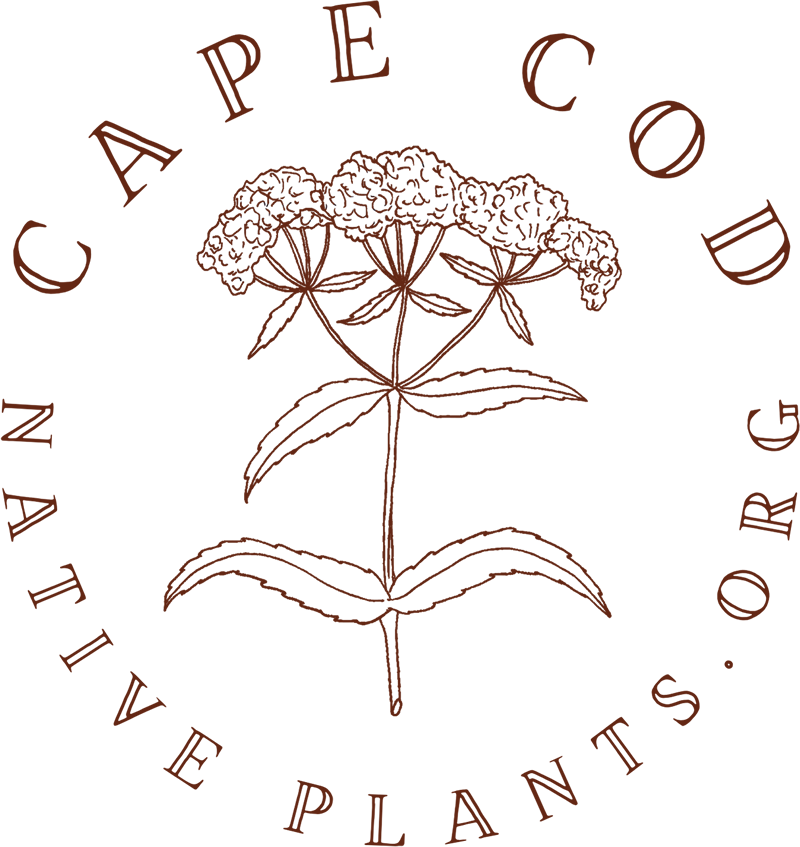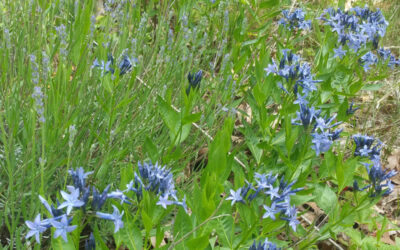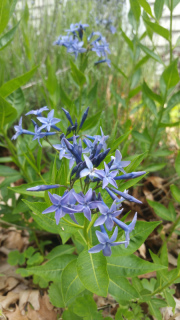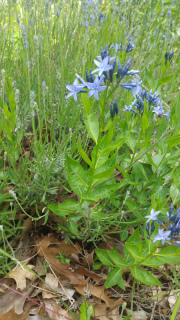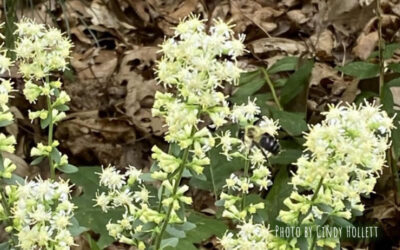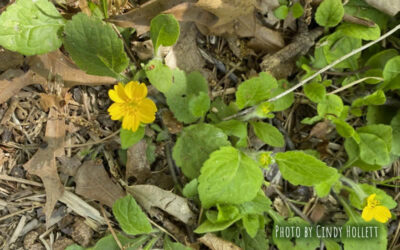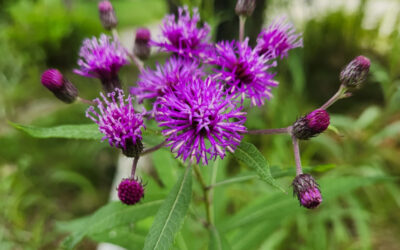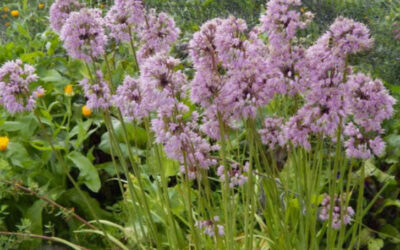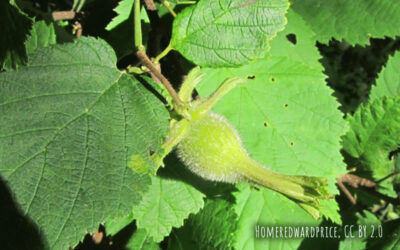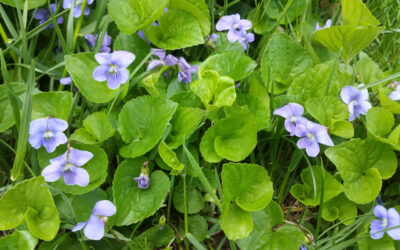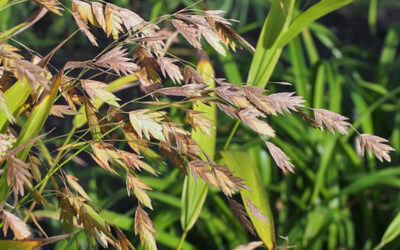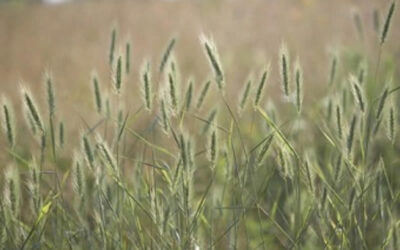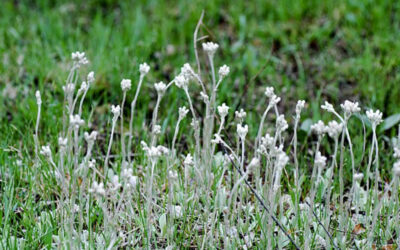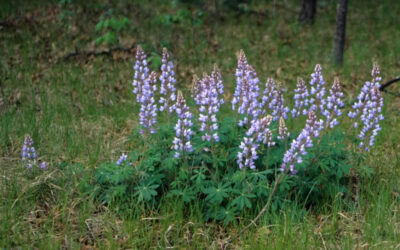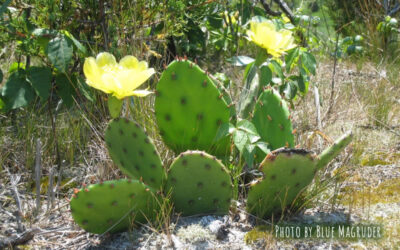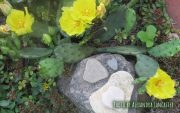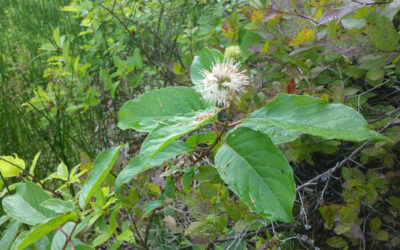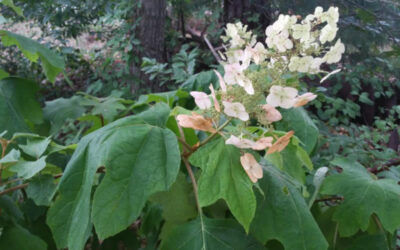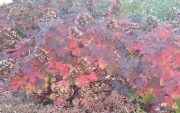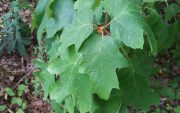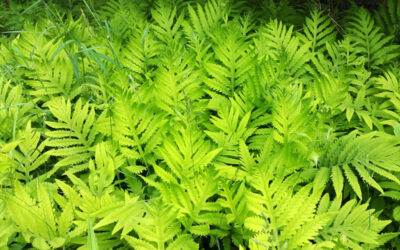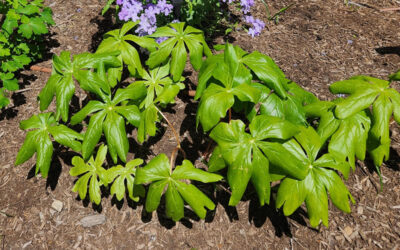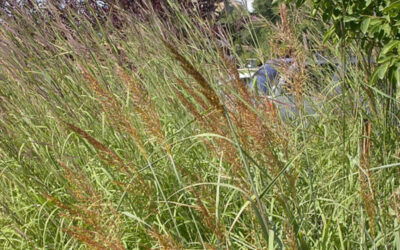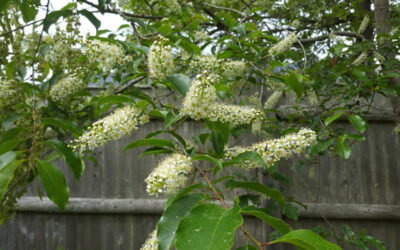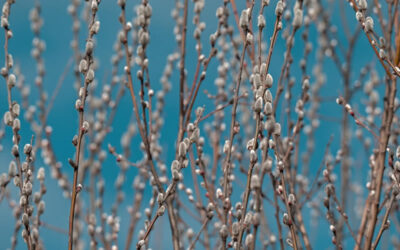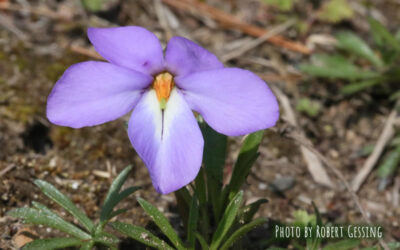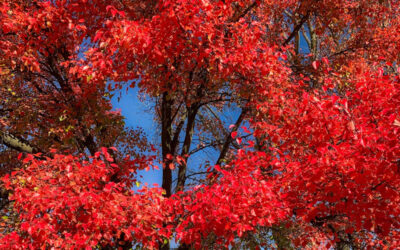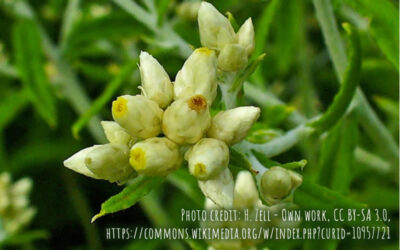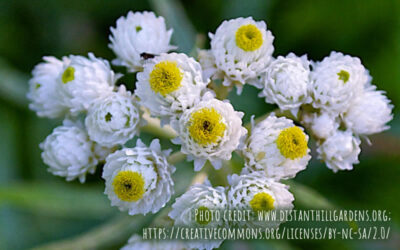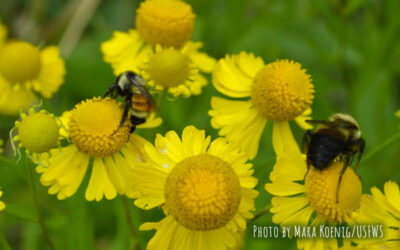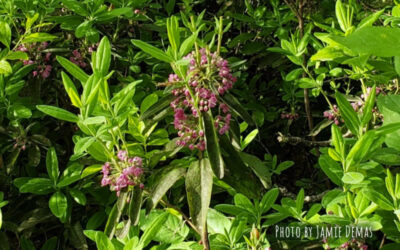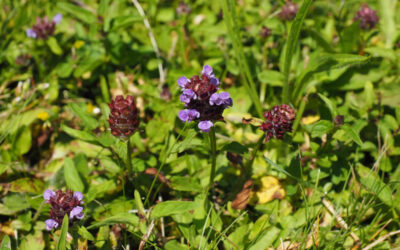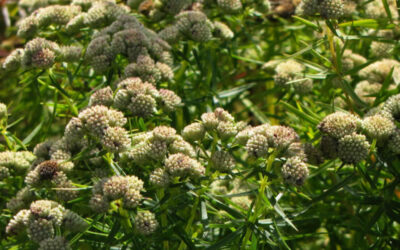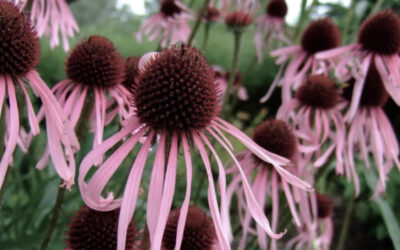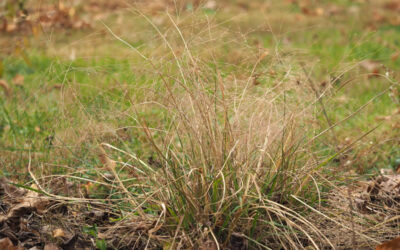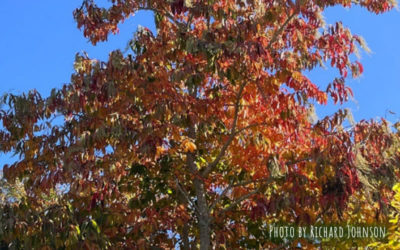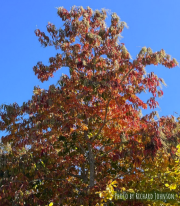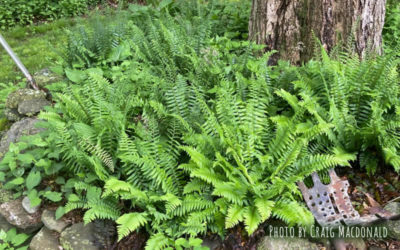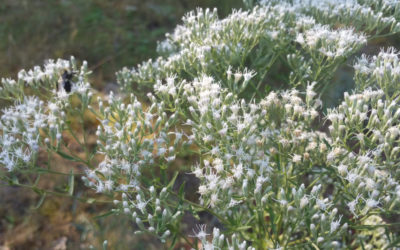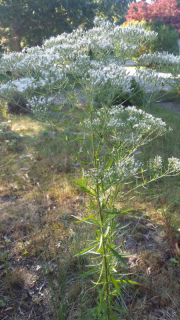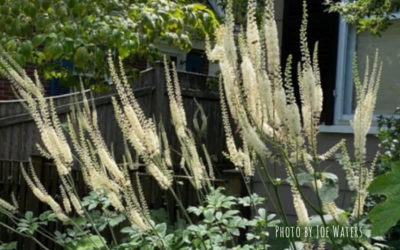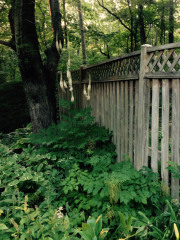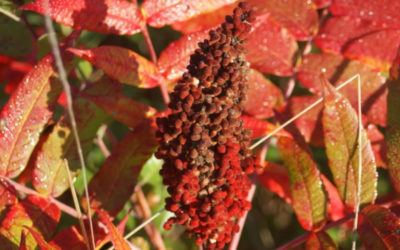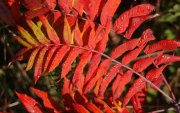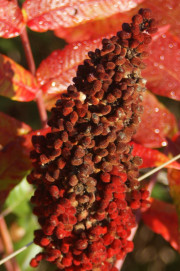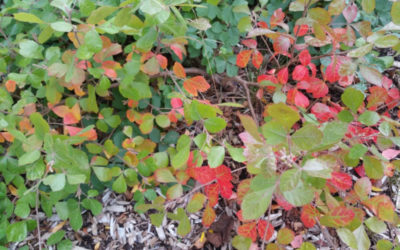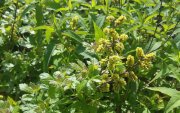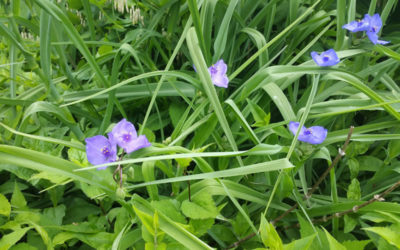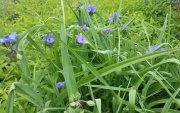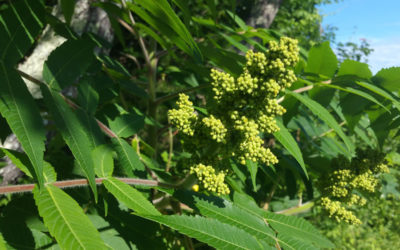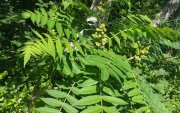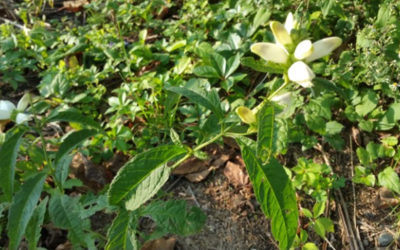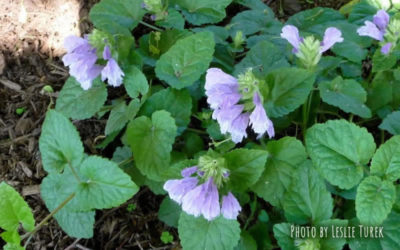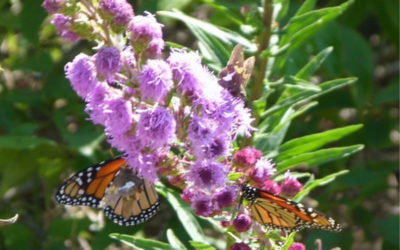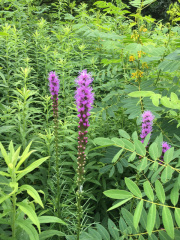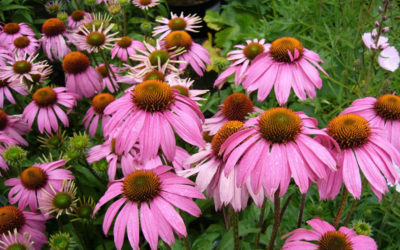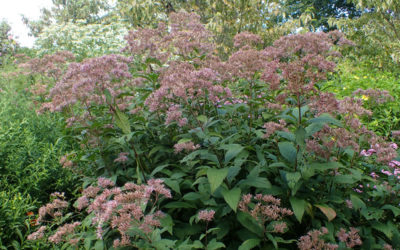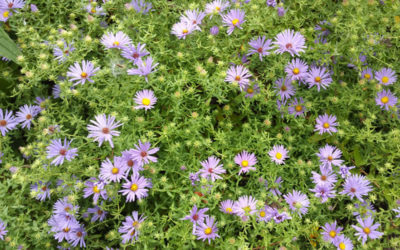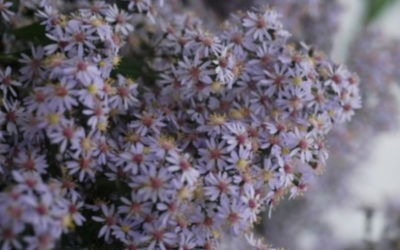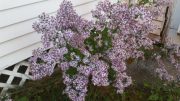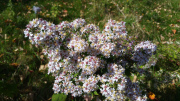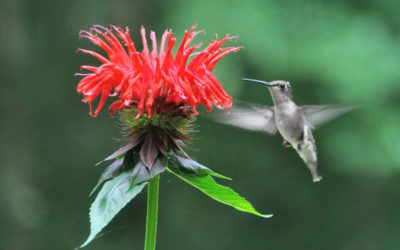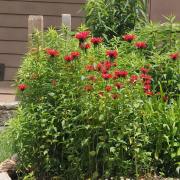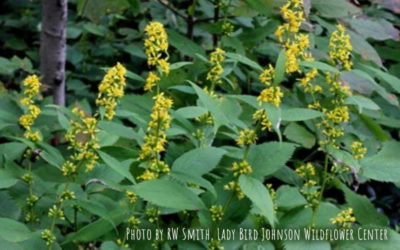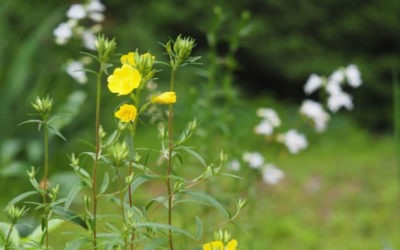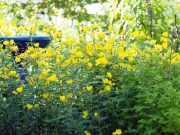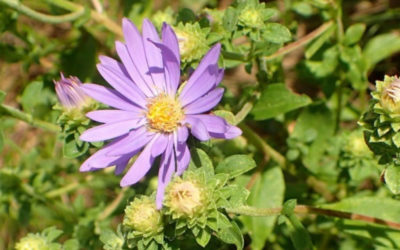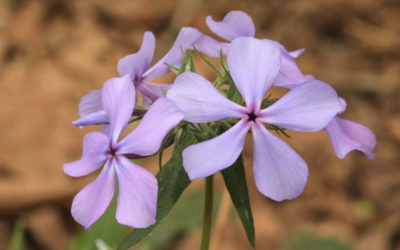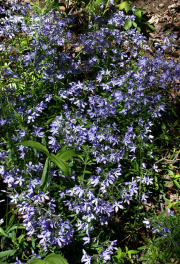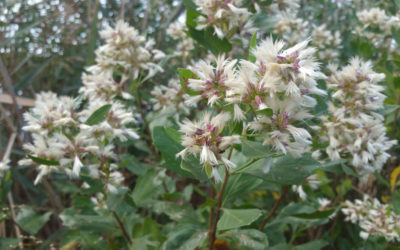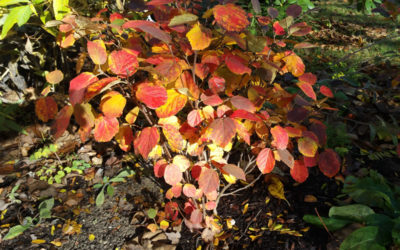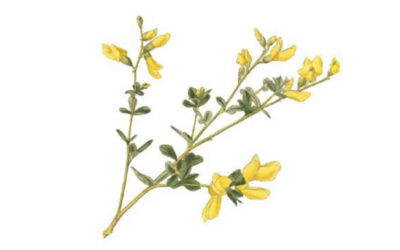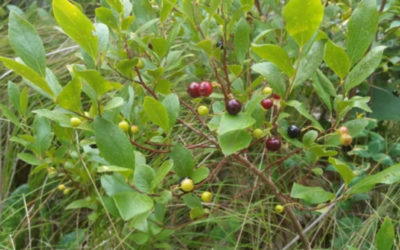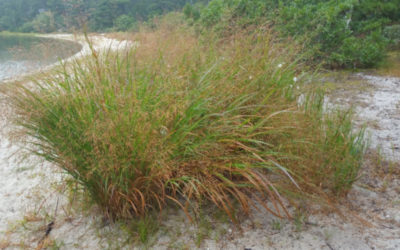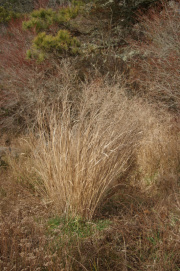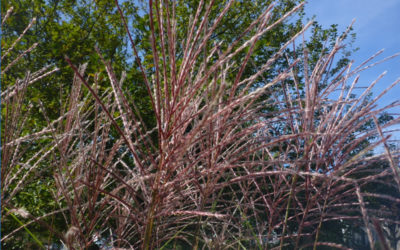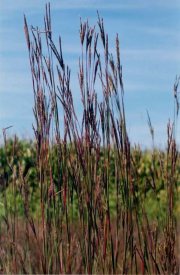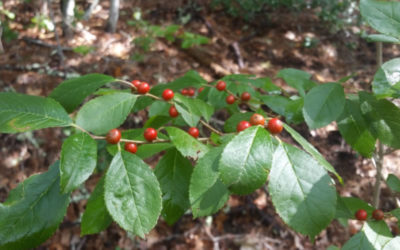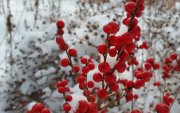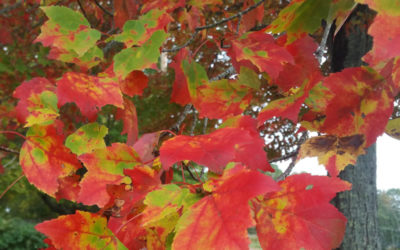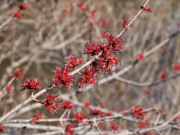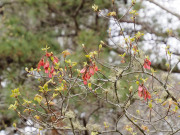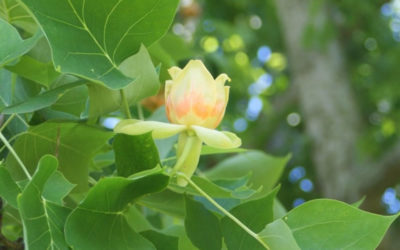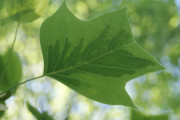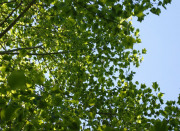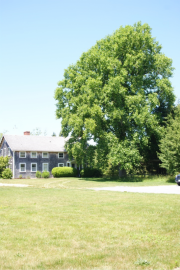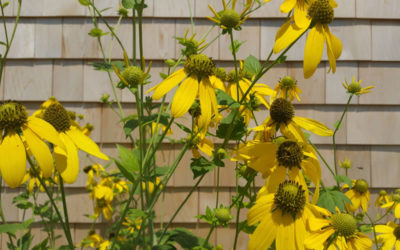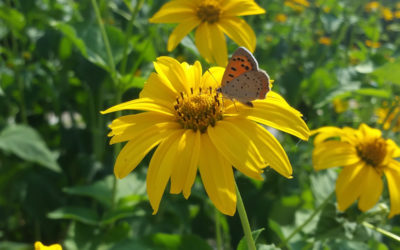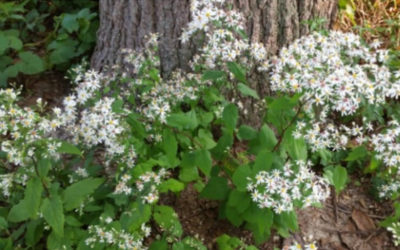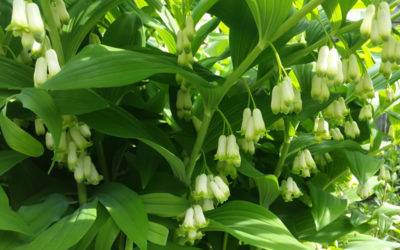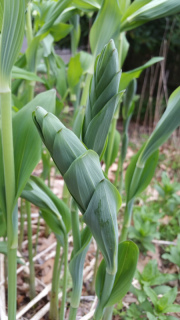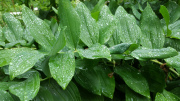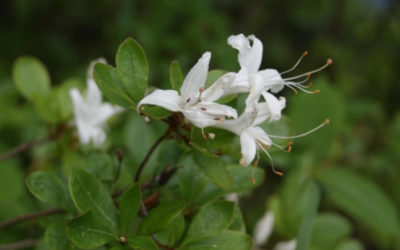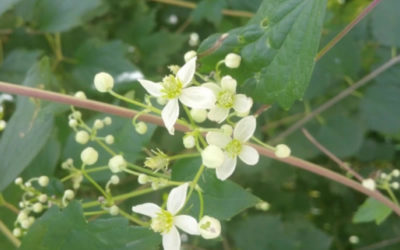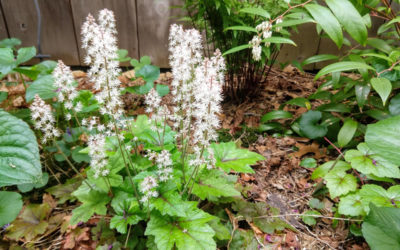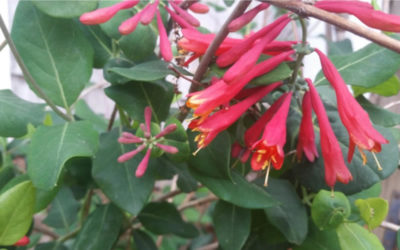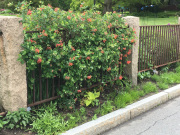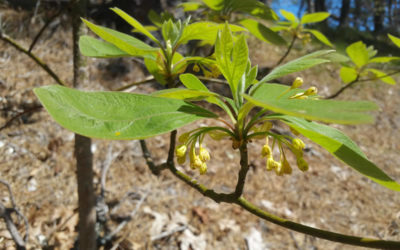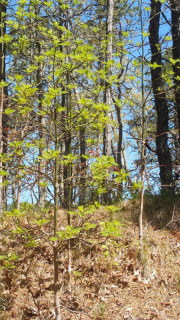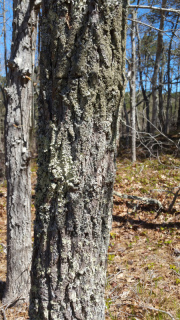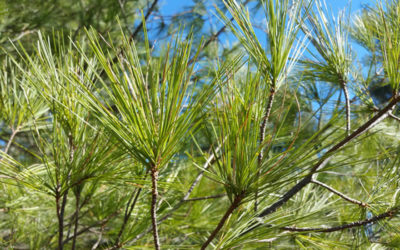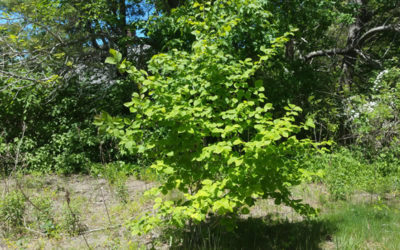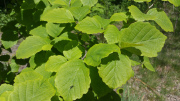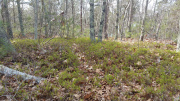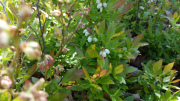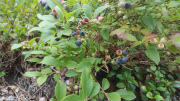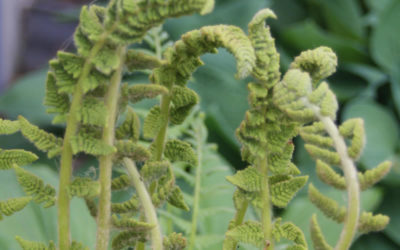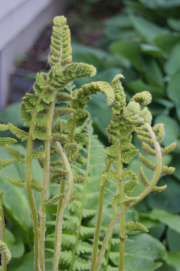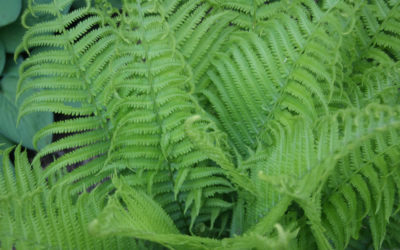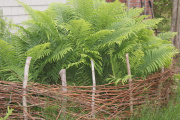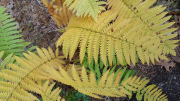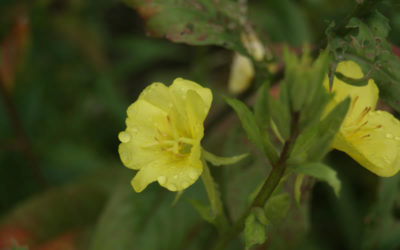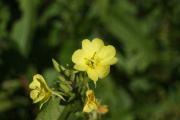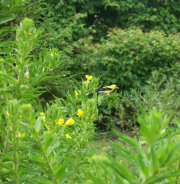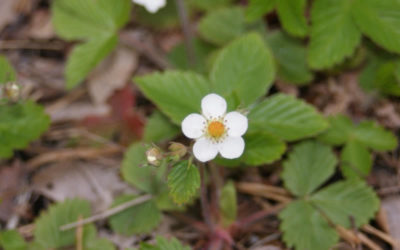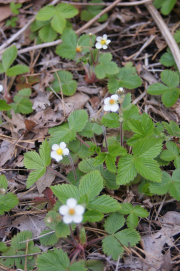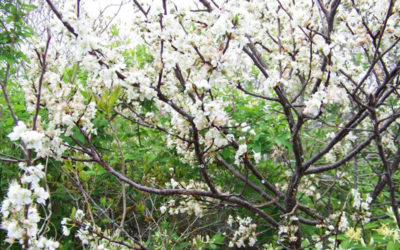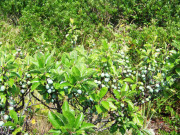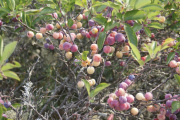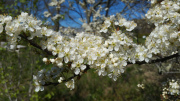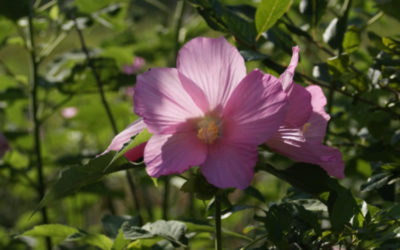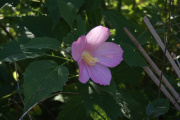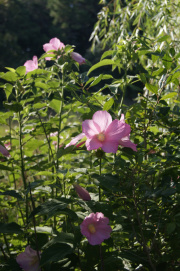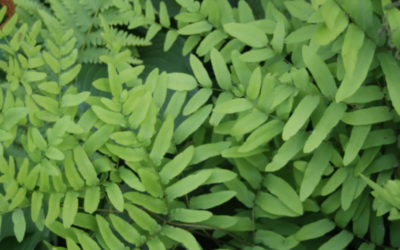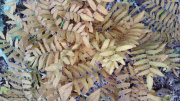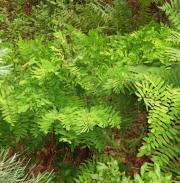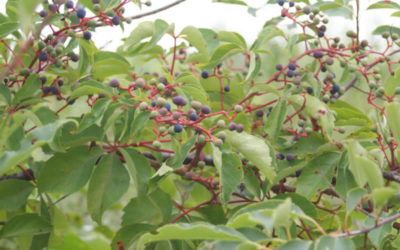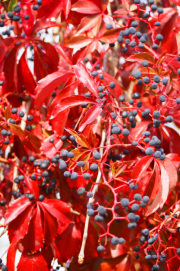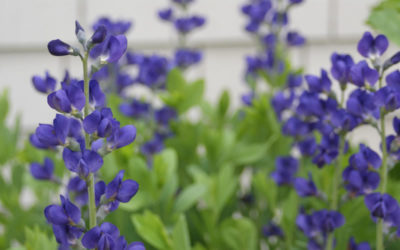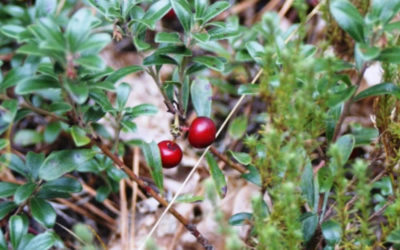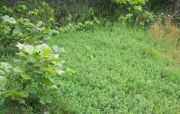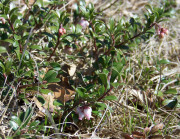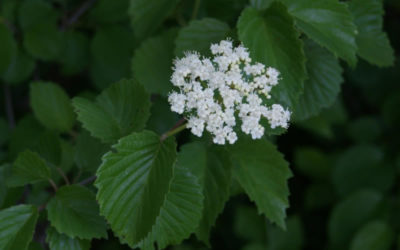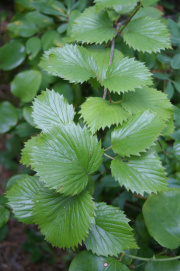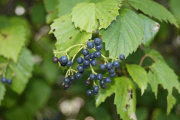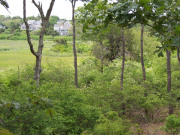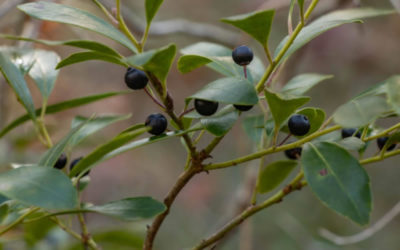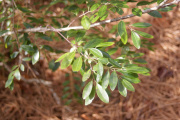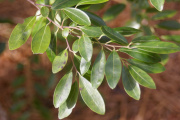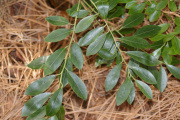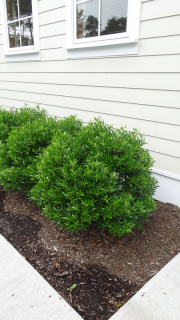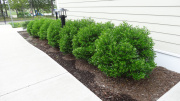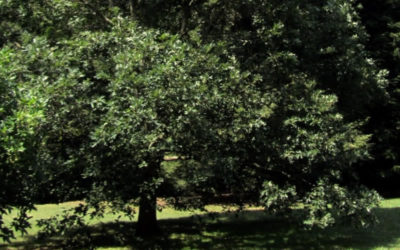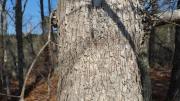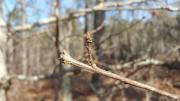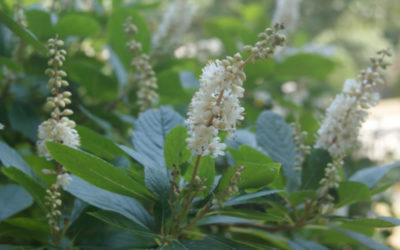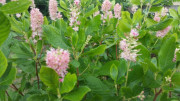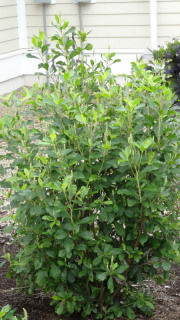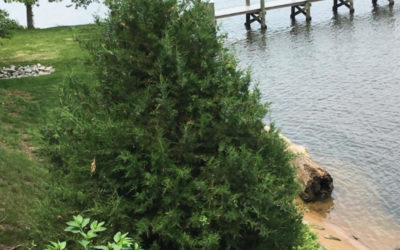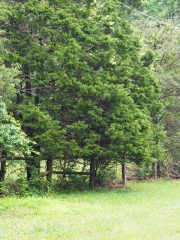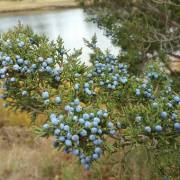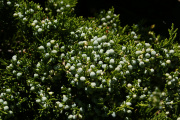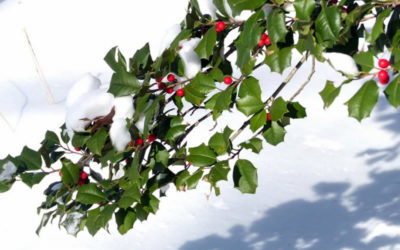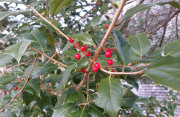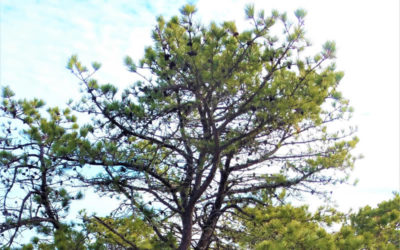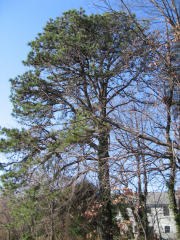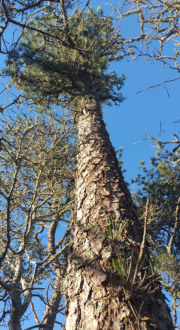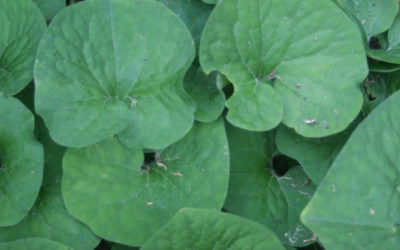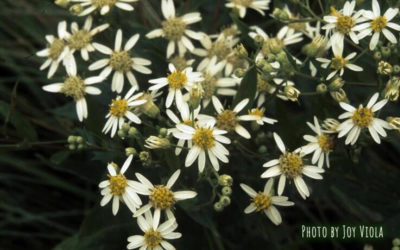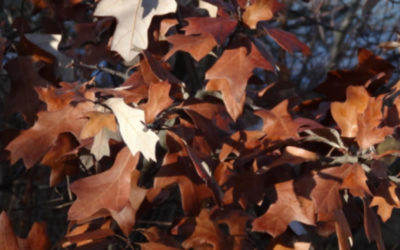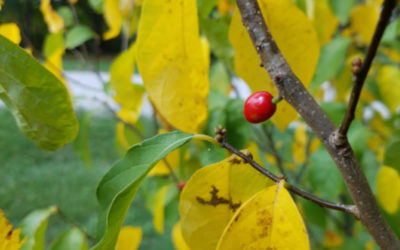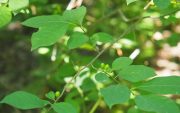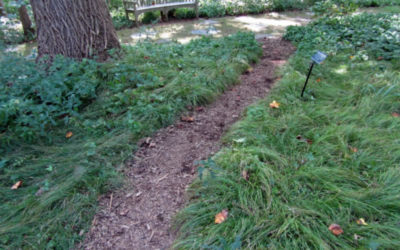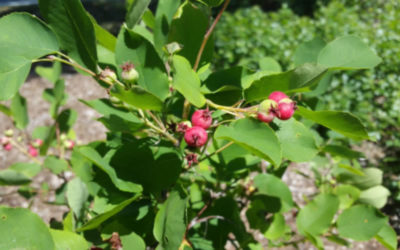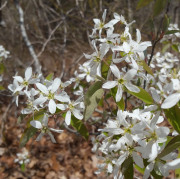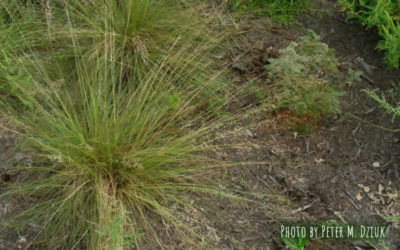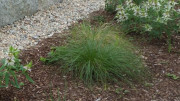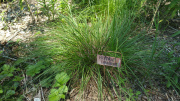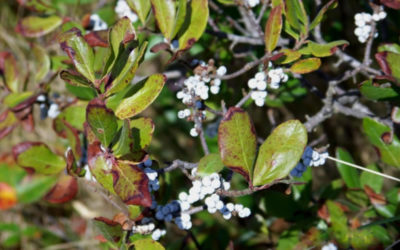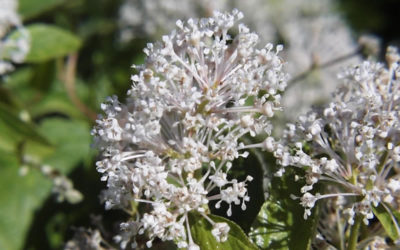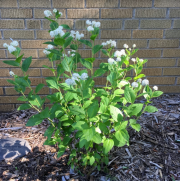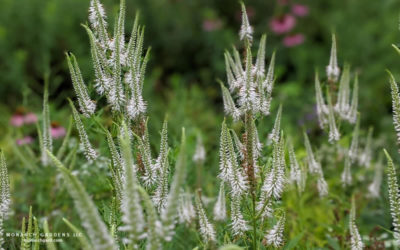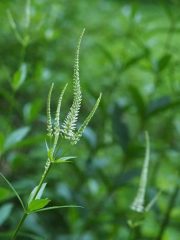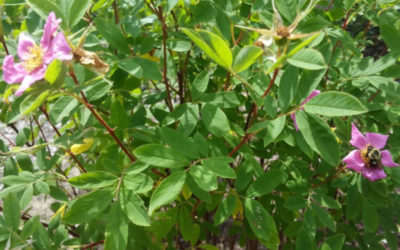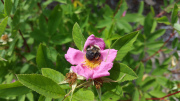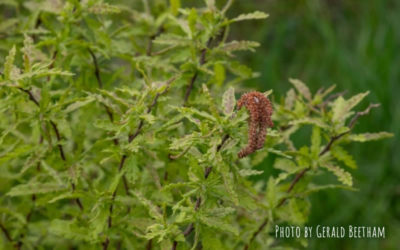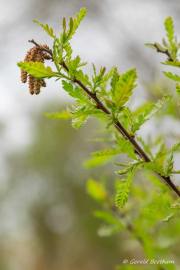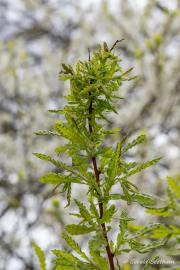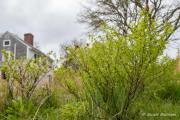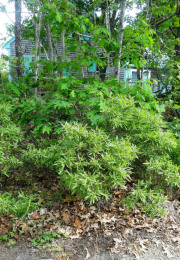Choose the Perfect Plant
This online tool is designed to help you find the native plants best-suited for specific sites that provide the greatest ecological function and benefit, and that will also complement your Cape Cod landscape design. Using the dropdowns below, you have the ability to find plants based on these six criteria: Plant Type, Sunlight, Soils, Bloom Month, Size, and Nature Benefits. Based on your choices, the results will automatically populate.
Eastern Bluestar
Amsonia tabernaemontana
Growing Information
• Plant Type: Perennial
• Sunlight: Full Sun to Partial
• Soils: sandy, clay, loamy
• Bloom Time: Blue flowers in May-June
• Size: 2-3ft tall with 2-3ft spread
Native to southern states and according to GoBotany.NativePlantTrust.org it is found in New England due to garden introduction. A good choice for containers, butterfly gardens, rain garden or naturalized garden. Prefers moist garden conditions, however once established it is drought tolerant. Slow grower, low care. Unpalatable to deer.
Garden Companions
Purple coneflower (Echinacea purpurea), False Indigo (Baptisia australis), Beardtongue (Penstemon digitalis)
Nature Benefits
• Attracts hummingbirds, carpenter bees, hummingbird moths, and butterflies like mourning cloak.
• Larval host for coral hairstreak butterfly.
Natural Habitat
Naturally occurs meadows, fields, shores of rivers or lakes.
Photos
Silverrod / White Goldenrod
Solidago bicolor
Growing Information
• Plant Type: Perennial
• Sunlight: Full to partial sun
• Soils: poor, sandy, clay; dry to average moisture
• Bloom Time: White to yellowish flowers July through October
• Size: 1-3 feet tall; 1ft spread
This is an east coast native that is extremely drought and salt tolerant. Sap is distasteful to deer and rabbits. Like all goldenrods, it does not contribute to hayfever and is extremely important to supporting local food webs.
Garden Companions
Little bluestem grass (Schizachyrium scoparium); Yellow Wild Indigo (Baptisia tinctoria); Blue Wood Aster (Symphyotrichum cordifolium)
Nature Benefits
• Attracts a wide variety of pollinators, including specialized bees.
• Host plant for caterpillars of brown-hooded owlet, wavy-lined emerald, and others.
• Seeds are eaten by songbirds.
Natural Habitat
Open woodlands.
Green and Gold
Chrysogonum virginianum
Growing Information
• Plant Type: Perennial
• Sunlight: Partial to full shade
• Soils: moist, well-drained
• Bloom Time: Yellow flowers mostly in spring, with sporadic flowers into September
• Size: 6 inches, spread 24 inches
Low growing semi-evergreen groundcover. Drought tolerant and good for naturalizing. Native to Pennsylvania and states south. Plant is susceptible to mildew in situations with poor drainage and too much mulch limiting air flow around the leaves. Resistant to fire. Early spring flowers support pollinators. Plant along woodland edges, walkways, rock gardens.
Garden Companions
Dwarf Iris (Iris cristata), Foam Flower (Tiarella spp), Eastern Wood Fern (Dryopteris marginalis)
Nature Benefits
• Attracts wide variety of pollinators looking for early season nectar.
• Seeds are eaten by songbirds.
Natural Habitat
Naturally occurs in woodlands.
New York Ironweed
Vernonia novaboracensis
Growing Information
• Plant Type: Perennial
• Sunlight: Full sun to part shade
• Soils: Medium moisture
• Bloom Time: Purple flowers late August through September
• Size: 4-6ft in height
A tall, coarse, and upright plant that creates beautiful deep purple flowers that turn into rusty seed clusters. This plant is great for bordering backyard garden areas and wildflower gardens. Needs consistent moisture to be happy but will tolerate short periods of dryness. Native to Barnstable County.
Garden Companions
Goldenrod (Solidago spp); White Wood Aster (Eurybia divaricatus)
Nature Benefits
• Important nectar source for many species of bees, butterflies, skippers, and moths.
• Seedheads are eaten by birds.
Natural Habitat
Occurs naturally in thickets along streams, pondshores, fields and meadows.
Nodding Onion
Allium cernuum
Growing Information
• Plant Type: Perennial
• Sunlight: Full to part sun
• Soils: prefers moist, circumneutral pH soils, but is tough and adaptable to drier spots.
• Bloom Time: June-September
• Size: Up to 2 feet tall when flowering.
Pompom-shaped, purple flowers appear on the plant throughout the summer. Seed head begins to droop as it matures, hence the name “nodding” onion. Not as edible as other Allium sp., so best saved for the bees! Can self-seed in ideal conditions and benefits from being divided after a few years. Other native Alliums such as Allium canadense (Wild Garlic) and Allium schoenoprasum (Wild Chives) are a bit tougher, but less showy. Not a Cape Cod native, but native to Long Island and states to the west and south.
Garden Companions
Purple Lovegrass (Eragrostis spectabilis), Butterflyweed (Asclepias tuberosa), Anise Hyssop (Agastache foeniculum), Asters (Symphyotrichum spp.)
Nature Benefits
• Highly attractive to butterflies, bees, and hummingbirds
Natural Habitat
Dry to moist prairies, stream banks, open woodlands.
Beaked Hazelnut
Corylus cornuta
Growing Information
• Plant Type: Shrub
• Sunlight: Full, partial
• Soils: Medium-dry to Moist, well-drained
• Bloom Time: February, March
• Size: 3-8ft tall
A true Cape Cod native shrub. Foliage turns bright yellow in fall. Male catkins appear before the leaves. Flowers are inconspicuous pinky-purple and are wind pollinated. The nuts are enclosed in a husk that extends beyond the nut to form the “beak.” Nuts are a favorite of wildlife. Its long catkins are a welcome sight in the garden in late winter. It is an attractive shrub in a woodland garden.
Garden Companions
Serviceberry (Amelanchier canadensis); Padoga Dogwood (Cornus alterniflora); Ninebark (Physocarpus opulifolius)
Nature Benefits
• Nuts are favorite of wildlife
Natural Habitat
Forests, and forest edges.
Common Blue Violet
Viola sororia
Growing Information
• Plant Type: Perennial
• Sunlight: Part shade or light, filtered shade. Tolerates full sun in wetter soil.
• Soils: Average to moist, well drained soils
• Bloom Time: April, May, June
• Size: 4-10 inches high
A wonderful and easy to grow wildflower which readily self-seeds. Excellent for planting in masses under deciduous trees, on the borders of flower beds, or filling a shaded, low-traffic area of a lawn. Better to have many growing because their greens are food source for small mammals, turkeys, quail, and caterpillars. Also edible for humans! More information on the many other native species in the genus viola, and their habitats, can be found on https://gobotany.nativeplanttrust.org/
Garden Companions
Wild Columbine (Aquilegia canadensis); Pennsylvania Sedge (Carex pensylvanica), Heartleaf Aster (Symphyotrichum cordifolium), Canada Anemone (Anemonastrum canadense)
Nature Benefits
• Provides nectar and nesting material for native bees.
• Leaves and seeds are eaten by small mammals, turkey, bobwhite quail, and grouse.
• Larval host for the Great Spangled Fritillary (Speyeria cybele)
Natural Habitat
Moist-average woodlands, woodland edges. Other viola species can be found in drier or wetter areas.
Northern Sea Oats
Chasmanthium latifolium
Growing Information
• Plant Type: Grass
• Sunlight: Part shade to shade. Tolerates more sun in wetter soils but prefers shade.
• Soils: Tolerates a wide range of soils.
• Bloom Time: July-September. Seed heads appear in the fall and persist into winter.
• Size: 4-10 inches high.
One of our most beautiful and adaptable ornamental grasses for fall and winter interest, and the only one with considerable shade tolerance. Will readily spread in richer, moist soils, but sticks to upright clumps in dry soils. Elegant drooping seed heads are a food source for birds and woodland mammals. Deer resistant, heat tolerant, and easy to divide and transplant.
Garden Companions
White Turtlehead (Chelone glabra); Black-eyed Susan (Rudbeckia hirta); Blue Lobelia (Lobelia siphilitica); Appalachian False Goat’s Beard (Astilbe biternata)
Nature Benefits
• Seedheads are late season food for small mammals and granivorous birds.
• Larval host for several species of skipper butterfly (family Hesperiidae)
Natural Habitat
Riverbanks, floodplains, moist woodland slopes and edges.
Virginia Wild Rye
Elymus virginicus
Growing Information
• Plant Type: Grass
• Sunlight: Sun to part shade
• Soils: Prefers heavy, rich, moist soils but will tolerate average sandy soils in shadier spots
• Bloom Time: March, April, May. Seed drops end of spring/early summer
• Size: Up to 4ft
A true problem solver! Mix with an aggressive warm season spreader like Prairie Cordgrass (Spartina pectinata) for a seed mix that can quickly reclaim eroded landscapes and out-compete problematic invasives like Japanese Knotweed (alongside cutting and hand-pulling first resprouts). Great for re-establishing native vegetation after intensive invasive species control or construction on moist slopes. Provides cover and food for wildlife.
Garden Companions
Prairie Cordgrass (Spartina pectinata), Northern Sea Oats (Chasmanthium latifolium), Black-eyed Susan (Rudbeckia hirta), Scarlet Beebalm (Mondarda didyma), Mountain Mints (Pycnathemum sp.)
Nature Benefits
• Rapid groundcover for protecting exposed soil from invasive weeds.
• Provides food for waterfowl and granivorous birds.
• Provides cover for frogs, small mammals, and birds.
Natural Habitat
Riverbanks, moist slopes and woodland edges, pasture.
Field Pussytoes
Antennaria neglecta
Growing Information
• Plant Type: Perennial
• Sunlight: Full to part sun
• Soils: Dry-Average, sandy or gravelly soils. Needs lean soils with good drainage.
• Bloom Time: April, May, June
• Size: 4-10 inches high.
A cute, inconspicuous groundcover for neglected areas and forms dense colonies. Excellent for seeding into a dry, patchy lawn, planting on a roadside strip, or a rock garden. Small, white flower spikes bounce around in the breeze like little cat paws. Bees and butterflies will visit the flowers. Several other similar Antennaria sp. may also be found in native plant nurseries.
Garden Companions
Wild Columbine (Aquilegia canadensis); Wavy hairgrass (Deschampsia flexuosa); Purple Lovegrass (Eragrostis spectabilis); Prairie smoke (Geum triflorum); Bearberry (Arctostaphylosuva-ursi)
Nature Benefits
• Provides pollen and nectar for native bees and butterflies.
• Larval host for the American Lady butterfly (Vanessa virginiensis)
Natural Habitat
Dry, open areas; roadsides, graveyards, old fields
Wild Sundial Lupine
Lupinus perennis
Growing Information
• Plant Type: Perennial
• Sunlight: Sun to part shade.
• Soils: Dry to Moist, well drained soils. Prefers light, sandy or gravelly soil.
• Bloom Time: May-July
• Size: Up to 2ft tall in bloom
An excellent choice for barren areas as the plant prefers not to compete with other plants and is excellent at colonizing open space. Prefers not to be transplanted, so it is best grown from seed. Nitrogen fixer, drought tolerant once established. The beauty of its bloom is unrivaled in late spring. Establish a population on your property and brag about it to your neighbors. Attractive to hummingbirds and butterflies. BEWARE of non-native look-alikes in nurseries, they threaten to displace wild populations of this threatened plant, putting insects that depend on this species at risk of extinction.
Garden Companions
Black-eyed Susan (Rudbeckia hirta), Purple Lovegrass (Eragrostis pectinacea), Pitch Pine (Pinus rigida)
Nature Benefits
• Larval host to the critically endangered Karner Blue Butterfly (Plebejus samuelis)
• Attracts butterflies, hummingbirds and native bees.
Natural Habitat
Sand dunes, pine barrens, open woodlands and clearings, especially after a wildfire or landslide.
Eastern Prickly Pear
Opuntia humifusa
Growing Information
• Plant Type: Perennial
• Sunlight: Full sun
• Soils: Dry, sandy or rocky soil. Needs good drainage.
• Bloom Time: June-August. Fruit in mid-fall.
• Size: Up to 18 inches tall. Usually creeping.
New England’s only native cactus! Beautiful showy flowers and delicious, edible purple fruit make this plant a wonderful, unique specimen for rock gardens, roadsides, and barren sand/gravel strips. Great contrast with sparse grasses and herbs. Wild plants are protected in MA.
Garden Companions
Purple Lovegrass (Eragrostis spectibilis), Butterfly Milkweed (Asclepias tuberosa), Anise Hyssop (Agastache foeniculum), Bearberry (Arctostaphylos uva-ursi), Wavy Hairgrass (Deschampsia flexuosa)
Nature Benefits
• Fruit for birds, small mammals and people!
• Provides nectar and pollen for native bees.
Natural Habitat
Dry, sandy and rocky areas such as dunes and gravel fields.
Photo Gallery
Buttonbush
Cephalanthus occidentalis
Growing Information
• Plant Type: Shrub
• Sunlight: Full to part sun
• Soils: Moist to wet soils. Tolerates standing water
• Bloom Time: Mid-Summer
• Size: up to 12 ft
Showy, pom-pom like flowers attract tons of butterflies and hummingbirds. Loves water. Makes an attractive hedge or accent shrub at the edge of a pond or in a marshy area. Flowers mature into button-like fruits filled with seeds which attract ducks and other water birds.
Garden Companions
Winterberry (Ilex verticillata); Blue Flag Iris (Iris versicolor); Cardinal Flower (Lobelia cardinalis); Swamp Milkweed (Asclepias incarnata); Highbush Blueberry (Vaccinium corymbosum)
Nature Benefits
• Provides nectar for native bees, hummingbirds, and butterflies
• Seeds are eaten by ducks and other waterfowl
• Larval host to several species of sphinx moth
Natural Habitat
Marshes, wet meadows, bogs, and pond edges
Oakleaf Hydrangea
Hydrangea quercifolia
Growing Information
• Plant Type: Shrub
• Sunlight: Full sun to part shade or filtered shade
• Soils: Moist, well-drained soils
• Bloom Time: May, June, July
• Size: 6-8 feet.
Perfect size, low maintenance shrub for an informal hedge or as a showy specimen. Shade tolerant. Finely divided leaves reminiscent of oaks, and large white flower spikes persist throughout the season. Fabulous fall color, and the peely bark and dry flowers provide winter interest as well. Great replacement for the ever-popular non-native hydrangeas. Native to southern states but does well in Massachusetts landscapes.
Garden Companions
Southern Magnolia (Magnolia grandiflora); Flame Azalea (Rhododendron calendulaceum); Eastern Redbud (Cercis canadensis); Dwarf Crested Iris (Iris cristata)
Nature Benefits
• Insects overwinter in spent stems.
• Nesting material for birds
Natural Habitat
Moist woods, riverbanks of southern states.
Photo Gallery
Sensitive Fern
Onoclea sensibilis
Growing Information
• Plant Type: Perennial
• Sunlight: Part shade. Tolerates full sun in wet soils.
• Soils: Moist to wet, acidic soils
• Bloom Time: N/A
• Size: Up to 3 feet tall
Distinctive, coarsely lobed fern that spreads by rhizomes in wet areas. Great as an underplanting for shrubs or as a filler in wet meadows. It is named sensitive fern because it quickly withers after the first frost. Bright lime green foliage, often with reddish undertones on fiddleheads and stems.
Garden Companions
Golden Alexander (Zizia aurea); Wild Geranium (Geranium maculatum); Swamp Milkweed (Asclepias incarnata); Marsh Marigold (Caltha palustris)
Nature Benefits
• Shelters salamanders and frogs
• Can spread aggressively, protecting soil from exotic invasive spreaders.
Natural Habitat
Moist woods, floodplains, streambanks, marshy ditches
Mayapple / American Mandrake
Podophyllum peltatum
Growing Information
• Plant Type: Perennial
• Sunlight: Part Shade, Shade
• Soils: Average to Moist, acidic sandy loams.
• Bloom Time: April/May. Fruit in mid-summer.
• Size: 1-1.5ft tall. Spreads along the ground.
A unique woodland plant that grows very well in Cape Cod’s sandy deciduous forests. Interesting star-shaped foliage and spreading rhizomatic habit make this an excellent companion alongside native spring ephemerals. All parts of the plant are highly toxic to eat except the small yellow fruit, which has a lemony, candy-like flavor. Native to western MA.
Garden Companions
Deciduous trees – not pines! Woodland Phlox (Phlox divaricata), Bloodroot (Sanguinaria canadensis), Virginia Bluebells (Mertensia virginica), Golden Groundsel (Packera aurea)
Nature Benefits
• Fruit is eaten by box turtles and small mammals.
Natural Habitat
Mixed deciduous forest, shaded riverbanks and shaded fields.
Indian Grass
Sorghastrum nutans
Growing Information
• Plant Type: Grass
• Sunlight: Full to part sun
• Soils: Dry to moist soils
• Bloom Time: August-October
• Size: Up to 8ft tall
A beautiful, tall ornamental grass with a bronze, metallic sheen to the seedheads. Blueish green foliage turns yellow as it begins to produce seeds in the fall. A crucial species in tallgrass prairies and is best utilized in naturalized masses. Great plant for screening.
Garden Companions
Joe-Pye Weeds (Eutrochium sp.); Evening Primrose (Oenothera biennis); New York Ironweed (Vernonia noveborecensis); Ox-Eye Sunflower (Heliopsis helianthoides)
Nature Benefits
• Provides nesting material and cover for birds and native bees.
• Seed heads provide late season food for birds.
Natural Habitat
Fields, rocky shorelines, woodland openings, and roadsides.
Virginia Bird-cherry / Chokecherry
Prunus virginiana
Growing Information
• Plant Type: Tree
• Sunlight: Full sun to partial shade.
• Soils: Dry-Moist. Prefers richer loams but is highly adaptable.
• Bloom Time: May-June. Fruits in late summer.
• Size: up to 30ft. Varies depending on light and soil conditions.
A large shrub or small deciduous tree with impressive adaptation to a wide variety of growing conditions. Can grow as a forest tree in moist shade or as a shrub on dry bluffs. Profuse cream- white flowers in late spring. Fruits are puckery sour but addictive and make a good July snack. Very attractive plant to birds and butterflies.
Garden Companions
Scrub Oak (Quercus ilicifolia); White Oak (Quercus alba); Pitch Pine (Pinus rigida); Sassafrass (Sassafras albidum); New Jersey Tea (Ceanothus americanus)
Nature Benefits
• Provides nectar for native bees and butterflies.
• Important food source for birds and mammals.
• Larval host to a huge variety of moths and butterflies such as hairstreaks and sphinx moths.
Natural Habitat
Moist woods, stream banks; prairie hillsides, fence rows, roadsides; sandy bluffs
Pussy Willow
Salix discolor
Growing Information
• Plant Type: Shrub
• Sunlight: Full sun
• Soils: Moist to wet soils.
• Bloom Time: February, March
• Size: Up to 20ft tall, often shorter. Tolerates being cut back aggressively.
Fast growing shrub. Appreciates being cut back every few years to encourage vigorous new suckering growth. Fuzzy buds appear in late winter and open into sticky catkins which provide nectar and pollen during a crucial time of the year when food is scarce. Beautiful as an accent in cut flower arrangements. Propagates easily from cuttings. BEWARE of non-native hybrids in nurseries – they do not support native insects.
Garden Companions
American Blue-flag (Iris versicolor); Swamp Rosemallow (Hibiscus moscheutos); Marsh Marigold (Caltha palustris); Winterberry (Ilex verticillata)
Nature Benefits
• Provides nectar for native bees very early in the year when food is scarce.
• Larval host to many butterflies and moths, including the Morning Cloak (Nymphalis antiopa), Viceroy (Limenitis archippus), and the Cecropia Moth (Hyalophora cecropia).
• Birds feed on the buds and catkins; twigs are browsed by deer.
Natural Habitat
Marshy, low areas; streambanks and ditches.
Bird’s Foot Violet
Viola pedata
Growing Information
• Plant Type: Perennial
• Sunlight: Full sun to partial, filtered shade
• Soils: Dry, acidic, sandy or gravelly soils. Needs good drainage.
• Bloom Time: April – June
• Size: 4-10 inches high
Beautiful lilac-colored flowers, larger than most violets – more like a pansy. A low, clumping perennial, easily identified by its finely divided bird’s foot-like leaves. Does well in poor upland soils, prefers not to compete with other plants. Great for rock gardens.
Garden Companions
Wild Columbine (Aquilegia canadensis); Wavy Hairgrass (Deschampsia flexuosa); Purple Lovegrass (Eragrostis spectabilis); New Jersey Tea (Ceanothus americanus); Lowbush Blueberry (Vaccinium angustifolium)
Nature Benefits
• Provides nectar for native bees and butterflies.
• Larval host for the Regal Fritillary (Speyeria idalia)
Natural Habitat
Rocky, open woods; sandy prairies and pine barrens
Tupelo/Black Gum
Nyssa sylvatica
Growing Information
• Plant Type: Tree
• Sunlight: Full sun, part sun
• Soils: Medium to wet soils.
• Bloom Time: Small green flowers from April-May, producing a sour black fruit in fall.
• Size: 20-50 feet in height.
Spectacular fall colors and pyramidal shape. Extremely high wildlife value, as the fruits are enjoyed by birds and small mammals and the flowers are important for early spring pollinators. The fruit is edible but quite sour. This tree is a favorite of European honeybees for nesting and honey production. Slow grower and can live over 600 years.
Garden Companions
Red Maple (Acer Rubrum); Great Rhododendron (Rhododendron maximum); Mountain Laurel (Kalmia latifolia); Canada Mayflower (Maianthemium canadense); Southern Magnolia (Magnolia Grandiflora); Native ferns
Nature Benefits
• Provides nectar for native bees.
• Attracts birds and small mammals with fruit in the fall.
• Hollows in the tree are very popular nesting sites for woodpeckers, owls, small mammals, and honeybees.
Natural Habitat
Moist deciduous forests and swamps. Occasionally tolerant of drier sites.
Rabbit Tobacco
Pseudognaphalium obtusifolium
Growing Information
• Plant Type: Annual
• Sunlight: Sun, part shade
• Soils: Medium to dry
• Bloom Time: White flowers in August, September, October too?
• Size: 1-3 feet in height
Also called sweet everlasting the leaves give off a maple syrup fragrance. Appropriate for butterfly and pollinator gardens. Widespread in the eastern half of the US it has cobwebby or wooly stems and small heads. Used medicinally for many ailments by native tribes.
Garden Companions
Butterfly Weed (Asclepias tuberosa), Spotted Bee Balm (Monarda punctata), Black-eyed Susan (Rudbeckia hirta), Culver’s Root (Veronicastrum virginicum), Golden Alexander (Zizia aurea)
Nature Benefits
• Larval host for the American Lady butterfly
• Flower nectar attracts bees, butterflies, wasps, and flies
Natural Habitat
Occurs in dry clearings, fields, and wood edges.
Pearly Everlasting
Anaphalis margaritacea
Growing Information
• Plant Type: Perennial
• Sunlight: Sun, part shade
• Soils: Poor sandy, dry or average
• Bloom Time: White flowers in July, August, September
• Size: 1-3 feet in height; 1-2 foot spread
Plant in rock gardens or to fill wide areas on slopes. It forms pearly mounds good for garden edges. Separate male and female flowers. Blossoms keep their color and shape well and are used in dried flower arrangements. Used by Native Americans as a substitute for tobacco and as a medicinal herb and in folk medicine as a salve for burns. Widely found and native to Cape Cod.
Garden Companions
Little Bluestem (Schizachyrium scoparium), Pussytoes (Antennaria plantaginifolia), Sweet Everlasting (Pseudognaphalium obtusifolium), Whorled Milkweed (Asclepias verticillata)
Nature Benefits
• Food plant for painted lady butterflies
• Larval host plant to the American Lady and Skipper butterflies
Natural Habitat
Occurs in disturbed areas, fields, shores of lakes.
Common Sneezeweed
Helenium autumnale
Growing Information
• Plant Type: Perennial
• Sunlight: Sun, part shade
• Soils: Average, moist to wet
• Bloom Time: Yellow flowers in July, August, September
• Size: 1-3 feet in height; 2-3 foot spread
Plant this clump-forming perennial with daisy-like flowers in borders, meadows, and wild gardens. It blooms later in the summer when other blossoms have faded. Sneezeweed pollen does not cause allergies, but the leaves were crushed for snuff to induce sneezing for congestion or headaches. Not native on Cape Cod but is found in parts of New England.
Garden Companions
Rose Milkweed (Asclepias incarnata), Purple Coneflower (Echinacea purpurea), Joe Pye Weed (Eutrochium maculatum), Obedient Plant (Physostegia virginiana), New England Aster (Symphyotrichum novae-angliae), Great Blue Lobelia (Lobelia siphilitica)
Nature Benefits
• Attracts bees and other pollinators.
• Foliage is toxic and bitter, so mammalian herbivores don’t feed on it.
Natural Habitat
Occurs in meadows, shores of lakes, wetlands
Appalachian Mountain Mint
Pycnanthemum flexuosum
Growing Information
• Plant Type: Perennial
• Sunlight: Sun, part shade
• Soils: Average, moist
• Bloom Time: White flowers in July, August
• Size: 2-3 feet in height; 1-3 foot spread
An aromatic, good soil stabilizer, it produces silvery white flowers above light green foliage. This species is not aggressive and will slowly expand. Plant in the border of a rain garden, pollinator, or native garden. Attracts throngs of desirable pollinators. Not a New England native but native to the southeast
Garden Companions
Black-eyed Susan (Rudbeckia hirta), Dense Blazing Star (Liatris spicata), Little Bluestem grass (Schizachyrium scoparium), Big Bluestem grass (Andropogon gerardii)
Nature Benefits
• Larval host for the Gray Hairstreak Butterfly and Wavy-lined Emerald
• Attracts bees, butterflies, moths, and wasps
Natural Habitat
Occurs in meadows, roadsides, open woodlands.
Sheep Laurel
Kalmia angustifolia
Growing Information
• Plant Type: Shrub
• Sunlight: Sun, part shade
• Soils: Average, dry or moist
• Bloom Time: Pink flowers in June, July
• Size: 1-3 feet in height; 1-3 foot spread
Adaptable to a variety of sites, plant in naturalized areas, foundation plantings, or woodland gardens. The showy Sheep Laurel is allelopathic, roots exude chemicals that inhibit conifer growth, it is also toxic to many mammals. It may form large evergreen colonies. The flowers are miniatures of Mountain Laurel. Native to Cape Cod.
Garden Companions
Christmas Fern (Polystichum acrostichoides), Wintergreen (Gaultheria procumbens), Sweet Fern (Comptonia peregrina)
Nature Benefits
• Provides winter forage and cover for birds
• Caterpillar host for the White Slant-line and the Mottled Gray Carpet moths
Natural Habitat
Found in forests, shores of ponds and lakes, bogs, and woodlands.
Selfheal
Prunella vulgaris
Growing Information
• Plant Type: Perennial
• Sunlight: Sun, part shade
• Soils: Moist, rich
• Bloom Time: Purple flowers in July, August
• Size: 6-12 inches in height
Selfheal is easy to grow under most conditions and can be aggressive. The common name comes from worldwide medicinal use of this plant. The leaves can be eaten cooked or raw. The plant commonly found in lawns is thought to be the Eurasian variety. Native to Cape Cod and the US.
Garden Companions
Butterfly Milkweed (Asclepias tuberosa), Black-eyed Susan (Rudbeckia fulgida)
Nature Benefits
• Flowers attract bees, small butterflies, and skippers.
• Larval host for the Clouded Sulphur Butterfly.
• Provides nectar for the Zabulon Skipper.
Natural Habitat
Occurs in meadows and fields, woodland borders, roadsides.
Slender Mountain Mint
Pycnanthemum tenuifolium
Growing Information
• Plant Type: Perennial
• Sunlight: Sun, part shade
• Soils: Average, dry
• Bloom Time: White flowers in July, August, September
• Size: 8-20 inches in height; 12-36 inch spread
In addition to being a good garden plant with the narrow leaves and small white flower clusters Slender Mountain Mint stands out because of its above average attraction for pollinators. Plant in a perennial border, pollinator garden, rain garden, or near the vegetable garden to entice pollinators. The aromatic plant with shallow rhizomes is more aggressive than other Pycnanthemums so needs root pruning to keep from spreading. This is also called Narrow Leaved Mountain Mint and is native to Cape Cod.
Garden Companions
Sweet Black-eyed Susan (Rudbeckia hirta), Dense Blazing Star (Liatris spicata), Little Bluestem grass (Schizachyrium scoparium), Big Bluestem grass (Andropogon gerardii)
Nature Benefits
• Flowers attract a wide variety of pollinators.
• Larval host plant for Gray Hairstreak Butterfly.
Natural Habitat
Occurs in meadows and fields, dry rocky, open woods, pine barrens.
Pale Purple Coneflower
Echinacea pallida
Growing Information
• Plant Type: Perennial
• Sunlight: Sun, part sun
• Soils: Rich, dry to moist
• Bloom Time: Pale purple to pink flowers in June, July
• Size: up to 3 feet in height; 1 foot spread
Low maintenance and resilient with lance shaped drooping rays with a bold central reddish brown cone. Good planted with native grasses. Blooms earlier than purple coneflower so planted together gives many weeks of blooms. Many medicinal uses. Found on Cape Cod but not native here.
Garden Companions
Purple Coneflower (Echinacea purpurea), Butterfly Milkweed (Asclepias tuberosa), Little Bluestem (Schizachyrium scoparium), Wild Bergamot (Monarda fistulosa), Dense Blazing Star (Liatris spicata)
Nature Benefits
• Attracts bees and butterflies.
• Provides nectar for hummingbirds and butterflies.
• Goldfinches eat seeds.
• Wavy-Line Emerald Moth feeds on flower heads.
Natural Habitat
Occurs in old fields and roadsides, open wooded hillsides, and pinelands.
Purple Lovegrass
Eragrostis spectabilis
Growing Information
• Plant Type: Perennial
• Sunlight: Sun, part shade
• Soils: Poor, average to dry
• Bloom Time: Bronzy purple/red inflorescence in August, September
• Size: 8-14 inches in height; 10-16 inch spread
Plant this low, bunching grass with a mounding habit in sunny open perennial borders, meadows, or along roadsides. The inflorescence exhibits a fluffy texture giving a purple haze to the landscape when planted in groups. Provides erosion control on roadsides and hillsides. Native to Cape Cod.
Garden Companions
Eastern Prickly Pear Cactus (Opuntia humifusa), Flowering Spurge (Euphorbia corollata), Black-eyed Susan (Rudbeckia fulgida), White Wood-aster (Eurybia divaricata)
Nature Benefits
• Popular with insect herbivores such as leafhoppers
• Caterpillar host for the Zabulon Skipper
• Birds use dry panicles for nesting
Natural Habitat
Occurs in coastal beaches, meadows and prefers disturbed sandy areas.
Sourwood
Oxydendrum arboreum
Growing Information
• Plant Type: Tree
• Sunlight: Sun, part shade
• Soils: Acidic, well-drained
• Bloom Time: July, August
• Size: 15 – 30 feet in height; 12 foot spread
This deciduous tree, while native to southwest Pennsylvania and states south, sourwood makes a good ornamental landscape tree on Cape Cod. It is in the heath family and its fragrant summer flowers are pollinated by insects and are a good source of nectar. Fall color is outstanding! Trees planted in the shade may grow taller and flower less. Salt tolerant and can withstand periodic droughts if established.
Garden Companions
Black Huckleberry (Gaylussacia baccata), Bayberry (Morella pensylvanica), Mountain Laurel (Kalmia latifolia)
Nature Benefits
• Attracts pollinators and butterflies
• Attracts songbirds
• Host plant of sphinx moths
Native Habitat
In its native range, found as single trees at forest edges, often within upland oak forests.
PHOTOS
Christmas Fern
Polystichum acrostichoides
Growing Information
• Plant Type: Perennial
• Sunlight: Part to full shade
• Soils: Medium to Moist, well-drained
• Bloom Time: Not a flowering plant
• Size: 1-2 feet in height
This glossy green leathery fern is green year-round. It grows in clumps. Silvery fiddleheads appear in spring. It grows happily in the Cape’s sandy soils but likes it moist and shady. It will grow successfully under walnut trees. Great choice for accent, borders, mass planting as a groundcover, or as a potted plant.
Garden Companions
Violets (Viola sororia), Trout Lily (Erythronium americanum), Wild Columbine (Aquilegia canadensis), Wild Geranium (Geranium maculatum)
Nature Benefits
• Provides winter cover.
• Songbirds use parts of the plant for nesting material.
Native Habitat
Occurs in woods, stream banks, swamps, and thickets.
Hyssop-leaved Boneset
Eupatorium hyssopifolium
Growing Information
• Plant Type: Perennial
• Sunlight: Sun to Part
• Soils: Wet to dry soil conditions
• Bloom Time: White flowers in August, September
• Size: 2-4 feet in height
This meadow plant is a vase shaped perennial. Foliage is narrow and gray green. In late summer plants are covered with dense flat terminal clusters of white florets. The clouds of flowers attract a myriad of pollinators. This species thrives in well drained or dry sites. Good in a grouping or mass planting. Use in a cottage garden, rain garden, perennial border, or xeric-scape design. This is a true Cape Cod native.
Garden Companions
Black-Eyed Susan (Rudbeckia hirta), Purple Coneflower (Echinacea purpurea), Little Bluestem (Schizachyrium scoparium), Goldenrods (Solidago spp), Dense Blazing Star (Liatris spicata)
Nature Benefits
• Unappealing to deer and rabbits.
• A favorite of butterflies, bees, and other pollinators.
• Particularly important to beneficial insects.
Native Habitat
Occurs naturally in sandy soils of fields, roadsides, pondshores, and cranberry bog borrow pits.
Photos
Black Cohosh / Bugbane
Actaea racemosa
Growing Information
• Plant Type: Perennial
• Sunlight: Partial sun, shade
• Soils: Moist, average
• Bloom Time: White spike flowers in June, July, August
• Size: 4-5 feet in height; 2-3 foot spread
Also known as black snakeroot with striking tall flower spikes and sharply divided foliage. It is an excellent choice for massing in a naturalistic garden. Flowering commences as spring wildflowers fade. Deer and rabbit resistant. Formerly Cimicifuga racemosa. Extremely rare in the wild in Massachusetts and some populations are introduced as escapes from gardens. Not found naturally on Cape Cod. Native to states west and south in the eastern U.S.
Garden Companions
Wild Geranium (Geranium maculatum), Blue Cohosh (Caulophyllum thalictroides), Joe Pye Weed (Eutrochium maculatum), Maple-leaved Viburnum (Viburnum acerifolium)
Nature Benefits
• Host plant for the Spring Azure.
• Attractive to pollinators.
Native Habitat
Occurs in forest edges and shady upland woods.
Photos
Smooth Sumac
Rhus glabra
Growing Information
• Plant Type: Shrub
• Sunlight: Full Sun, Partial, Shade
• Soils: Medium to dry
• Bloom Time: June, July
• Size: 10-20 feet tall, spread 20 feet
Colony-forming shrub – most noticeable for its brilliant fall color and bright red fruit. The plant is dioecious and only the female plants produce fruit. Sumac is effective where it has room to establish in its natural drift form. Colonies can be rejuvenated by cutting to the ground in mid-winter every few years. Great for dry, tough locations, especially on slopes. Great plant for restoration projects.
Garden Companions
Other species of sumac, Common Ninebark (Physocarpus opulifolius)
Nature Benefits
• Flowers attract pollinators
• Berries provide food for many birds
• Provides wild bees nesting materials and structure for their life cycles
Native Habitat
Occurs in old fields, hardwood forest edges, and dry uplands.
Photos
Fragrant Sumac
Rhus aromatica
Growing Information
• Plant Type: Shrub
• Sunlight: Full Sun, Partial
• Soils: Medium to dry
• Bloom Time: June, July
• Size: 2-6 feet tall, spread 6-10 feet
Good fast growing ground cover for banks and slopes. Can be massed or used in wind breaks. It suckers and roots where stems touch the ground and forms a dense stand. The straight species is usually tall and leggy in a garden setting, but the cultivar ‘Gro-Low’ is useful as a landscape plant for ground cover and stays no higher than three feet. Like all sumacs, it is dioecious, and fruit will only appear on female plants.
Garden Companions
Sweetfern (Comptonia peregrina), Little Bluestem Grass (Schizachyrium scoparium), Oakleaf Hydrangea (Hydrangea quercifolia), Flowering Dogwood (Cornus florida)
Nature Benefits
• Flowers attract pollinators
• Berries provide food for many birds and mammals
• Provides wild bees nesting materials and structure for their life cycles
Native Habitat
Occurs in old fields, hardwood forest edges, and dry uplands.
Photos
Spiderwort
Tradescantia ohiensis
Growing Information
• Plant Type: Perennial
• Sunlight: Full Sun, Partial
• Soils: Medium to dry
• Bloom Time: June, July
• Size: 2-4 feet tall
Its grass-like foliage grows in an upright form. The lavender blue flowers bloom from morning to midday, and close in the heat of the afternoon. This helps the plant conserve energy that can be put toward flowering for a longer period. A good choice for a rain garden.
Garden Companions
Foxglove Beardtongue (Penstemon digitalis), Wood Aster (Eurybia divaricata), Canada Anemone (Anemone canadensis)
Nature Benefits
• Attract pollinators and butterflies
Native Habitat
Occurs in fields and along roadsides.
Photos
Staghorn Sumac
Rhus typhina
Growing Information
• Plant Type: Shrub
• Sunlight: Full Sun, Partial, Shade
• Soils: Medium to dry
• Bloom Time: June, July
• Size: 15-25 feet tall
Colony-forming shrub – most noticeable for its brilliant fall color and bright red fruit. The plant is dioecious and only the female plants produce fruit. Staghorn sumac is effective where it has room to establish in its natural drift form. Colonies can be rejuvenated by cutting to the ground in mid-winter every few years. Great for dry, tough locations, especially on slopes. Great plant for restoration projects.
Garden Companions
Other species of sumac, Common Ninebark (Physocarpus opulifolius)
Nature Benefits
• Flowers attract pollinators
• Berries provide food for many birds
• Provides wild bees nesting materials and structure for their life cycles
Native Habitat
Occurs in old fields, hardwood forest edges, and dry uplands.
Photos
Turtlehead
Chelone glabra
Growing Information
• Plant Type: Perennial
• Sunlight: Sun, Part Sun
• Soils: Average, moist
• Bloom Time: White flowers in August
• Size: 2-4 feet in height
White Turtlehead is named for its distinctive flowers which are said to resemble a turtle’s head. It is mostly pollinated by bumblebees. In the wild, flower color can vary from pink to green. The vibrant Pink Turtlehead (Chelone lyonii) is often found in retail nurseries; however, this species of turtlehead is introduced to New England and is native to southeastern states. It appreciates a good, composted leaf mulch, particularly in sunny locations. A good choice for a rain garden.
Garden Companions
Red Cardinal Flower (Lobelia cardinalis), Great Blue Lobelia (Lobelia siphilitica), Rose Milkweed (Asclepias incarnata), Blue Flag Iris (Iris versicolor), and Coastal Plain Joe-pye Weed (Eutrochium dubium)
Nature Benefits
• Nectar source for hummingbirds and bumblebees
• Host plant for various species of moths and butterflies
Native Habitat
Occurs along shores of lakes, swamps, and wetland edges.
Meehan’s Mint
Meehania cordata
Growing Information
• Plant Type: Perennial
• Sunlight: Part shade, shade, sun
• Soils: Average, moist
• Bloom Time: Lavender blue in May, June
• Size: 4-8 inches in height; 4-32 inch spread
This rare well-behaved mint, with its trailing stems, will root as it spreads although less readily in dry shade than in moist shaded areas. Plant Meehan’s Mint as a groundcover, as living mulch under shrubs, or border edging in woodland or shade gardens. It prefers shade but tolerates dry sites in deep shade or full sun with sufficient moisture. This mint is not found in New England in the wild but is native to Pennsylvania and other states further to the south.
Garden Companions
Wild Columbine (Aquilegia canadensis), Plaintain Sedge (Carex plantaginea), Green and Gold (Chrysogonum virginianum)
Nature Benefits
• Nectar source for hummingbirds and insects
Native Habitat
Occurs in rich woods and wooded slopes.
Dense Blazing Star
Liatris spicata
Growing Information
• Plant Type: Perennial
• Sunlight: Sun, part shade
• Soils: Average, moist
• Bloom Time: Purple flowers in July, August
• Size: 12-24 inches in height; 12-18 inch spread
Also known as gayfeather it has an upright habit taking little space to grow. Well-suited for a small gardens, perennial border, natural or wildlife garden, or planted in masses. It is the most moisture-tolerant of the Liatris species. Cherokee used the plant, especially roots, in herbal medicine. Popular garden plant although not a native to Cape Cod. Native range is eastern U.S., but from Pennsylvania to the south. Good choice for a rain garden.
Garden Companions
New England Aster (Symphyotrichum novae-angliae), Obedient Plant (Physostegia virginiana), Big Bluestem (Andropogon gerardii), Purple Coneflower (Echinacea purpurea)
Nature Benefits
• Attracts native bees and butterflies, birds, and hummingbirds
• Seeds provide forage for wildlife
• Nectar source for Silver Spotted Skipper (Epargyreus clarus), Painted Lady (Vanessa Cardui)
Native Habitat
Occurs in wood openings, moist prairies, and marsh edges.
Photos
Purple Coneflower
Echinacea purpurea
Growing Information
• Plant Type: Perennial
• Sunlight: Sun, part shade
• Soils: Average, well-drained
• Bloom Time: Purple in July, August
• Size: 2-3 feet in height; 18-24 inch spread
Plant this easy-to-grow, drought tolerant wildflower in the perennial border or in masses. Native range includes New York and Pennsylvania and parts west. It is not a New England native, but it is a popular garden plant that does well on Cape Cod.
Garden Companions
Little Bluestem (Schizachyrium scoparium), Dense Blazing Star (Liatris spicata), Butterfly Milkweed (Asclepias tuberosa), Black-eyed Susan (Rudbeckia hirta), Obedient Plant (Physostegia virginiana)
Nature Benefits
• Nectar plant for native bees, butterflies, moths, beetles, flies, and wasps.
• Goldfinches eat seeds in the fall.
Native Habitat
Occurs in disturbed habitats, forest edges, and meadows.
Spotted Joe Pye Weed – ‘Gateway’
Eutrochium maculatum
Growing Information
• Plant Type: Perennial
• Sunlight: Full sun to part shade
• Soils: Average
• Bloom Time: August, September
• Size: 4-5 feet in height
Not indigenous to Cape Cod, but native to much of the rest of New England. Plants can be cut back to half its height in early summer for late summer blooms on shorter stems. This plant is best showcased in masses or dramatic accent in a cottage or wildlife garden. Flower heads are 12” wide clusters of flowers that will dry to seedheads giving interest to a winter garden. Cut back in early spring leaving 6-18” remaining to provide hollow stems for wild bees. Good choice for rain gardens and meadows. Makes a good cut flower.
Garden Companions
Obedient Plant (Physostegia virginiana), Dense Blazing Star (Liatris spicata), Boneset (Eupatorium perfoliatum)
Nature Benefits
• Pollinator magnet
• Seeds are attractive to birds
Native Habitat
Occurs naturally in openings in marshes, meadows, and fields.
Aromatic Aster
Symphyotrichum oblongifolium
Growing Information
• Plant Type: Perennial
• Sunlight: Prefers full sun
• Soils: Prefers lean, medium-dry soil conditions
• Bloom Time: Light purple flowers in September, October, sometimes into November
• Size: 2 feet in height, stiff stems will branch out giving a bush-like appearance
Native to other parts of the country, this is an aster that can be easily found in retail nurseries to add to late flowering plants to support pollinators. It is the leaves that are aromatic on this
aster. When in bloom, the light purple flowers cover the bush-like plant and slowly bronze to a reddish purple. The plant may “open up” if it gets too top heavy, so a good prune in June is helpful. This aster does well in lean soils.
Garden Companions
Black-Eyed Susan (Rudbeckia hirta), Purple Coneflower (Echinacea purpurea), Little Bluestem (Schizachyrium scoparium)
Nature Benefits
• Highly resistant to deer and rabbits
• A favorite for butterflies and bees
Native Habitat
In its native range, it occurs in rocky and sandy soils such as those found in prairies and bluffs as well as in moist woodland habitats.
Blue Wood Aster / Heart-leaved Aster
Symphyotrichum cordifolium
Growing Information
• Plant Type: Perennial
• Sunlight: Partial shade, full shade, full sun
• Soils: Medium to medium-dry soil conditions
• Bloom Time: Light blue flowers in September, October
• Size: 3 feet in height; 1-2 foot spread
Blue Wood Aster has a wonderful array of dainty blue flowers that attract butterflies and bees. It is an excellent fall bloomer in a perennial border when others are starting to fade. It also makes an attractive cut flower and is a great naturalizer at the edge of woods.
Garden Companions
Black-Eyed Susan (Rudbeckia hirta), Purple Coneflower (Echinacea purpurea), Blue-stemmed Goldenrod (Solidago caesia)
Nature Benefits
• Root system is an effective erosion control on hillsides.
• Offers nectar and pollen for butterflies and bees.
• Supports specialist Adrenid Bees.
• Host plant for Pearl Crescent butterfly caterpillars.
Native Habitat
Occurs at the woodland edge, upland meadows, and forests.
Photo Gallery
Scarlet Beebalm ‘Jacob Cline’
Monarda didyma ‘Jacob Cline’
Growing Information
• Plant Type: Perennial
• Sunlight: Sun, part shade
• Soils: Average, moist
• Bloom Time: Red in July, August
• Size: 3-4 feet in height; 3 foot spread
Plant in a wildlife or cut flower garden or meadow and enjoy the aromatic foliage and showy blooms. The Jacob Cline is common native beebalm cultivar that is resistant to powdery mildew and thrives, sometimes aggressively, in sunny, moist, well-drained soil. Also known as Oswego Tea because the leaves were used for tea by the Oswego Indians of New York. It is native to New York State and states south.
Garden Companions
Dense Blazing Star (Liatris spicata), Foxglove Beardtongue (Penstemon digitalis), Purple Coneflower (Echinacea purpurea), Culver’s Root (Veronicastrum virginicum), Little Bluestem (Schizachyrium scoparium)
Nature Benefits
• Nectar source for hummingbirds and swallowtail butterflies.
• Caterpillars of some moth species feed on the foliage.
Native Habitat
Occurs in moist open woods, meadows, stream banks.
Photos
Zigzag Goldenrod
Solidago flexicaulis
Growing Information
• Plant Type: Perennial
• Sunlight: Sun, Part shade, shade, sun
• Soils: Average, dry, moist
• Bloom Time: Yellow in August, September, October
• Size: 1-3 feet in height; 1-3 foot spread
Compact pollinator plant that is shade tolerant and well-suited for a wildlife or shade garden or a natural area. Zigzag Goldenrod is good for massing and will spread by seed unless it is deadheaded. Does not require mulching because it is adapted to dry conditions. Semievergreen basal leaves provide erosion control.
Garden Companions
Goldenrods (Solidago spp.), Oxeye Sunflower (Heliopsis helianthoides), Blue Wood Aster (Symphyotrichum cordifolium)
Nature Benefits
• Seeds attract Swamp Sparrows, Pine Siskins, and Meadow Mice
• Host plants for some moth caterpillar species
• Nectar plant for native bees, wasps, butterflies, and pollinating flies
Native Habitat
Occurs in forests, protected slopes, wooded shores of rivers or lakes.
Sundrops
Oenothera fruticosa
Growing Information
• Plant Type: Perennial
• Sunlight: Sun, Part shade
• Soils: Average, well-drained
• Bloom Time: Yellow in May, June, July
• Size: 12-24 inches in height; 24-30 inch spread
Plant as a companion in a border or meadow. Also called narrow-leaf evening primrose it grows in challenging conditions and provides yellow flowers for months. It is a rapid spreader but not usually aggressive. This evening primrose blooms during the day rather than the evening.
Garden Companions
Greater Tickseed (Coreopsis major), Goldenrods (Solidago spp.)
Nature Benefits
• Attracts wide variety of bees, birds, butterflies
• Larval host for Sphinx moths
Native Habitat
Occurs along edges of salt marshes, brackish ponds, and tidal rivers.
Photos
Showy Aster
Eurybia spectabilis
Growing Information
• Plant Type: Perennial
• Sunlight: Shade, Partial
• Soils: Medium to dry
• Bloom Time: August, September
• Size: 1-2 feet tall; 2 foot spread
Extremely drought tolerant. Plants are somewhat unpalatable to deer and rabbits. This plant will form small colonies, spreading by rhizomes, but it is not an aggressive spreader. A good addition to a pollinator garden, for mass plantings, cottage gardens and for naturalizing.
Garden Companions
Black-eyed Susan (Rudbeckia hirta), Anise-scented Goldenrod (Solidago odora), Pennyslvania Sedge (Carex pennsylvanica), Little Bluestem grass (Schizachyrium scoparium)
Nature Benefits
• Attracts pollinators
• Offers nectar for hummingbirds
Native Habitat
Occurs in woodlands.
Wild Blue Phlox
Phlox divaricata
Growing Information
• Plant Type: Perennial
• Sunlight: Shade, Partial
• Soils: Medium to dry
• Bloom Time: May, June
• Size: 1-2 feet in height
This true native wild phlox has five petals and opposite leaves. It is a native to Connecticut, but not indigenous to Cape Cod. It spreads by its roots, but slowly. The showy flowers of blue to lavender attract pollinators making it an excellent addition to a pollinator garden. It is also an effective, shallow-rooted cover for early spring bulbs. A good plant for a small space.
Garden Companions
Lady Fern (Athyrium filix-femina), Wild Columbine (Aquigelia canadensis), Calico Aster (Symphyotrichum lateriflorum)
Nature Benefits
• Attracts pollinators
• Offers nectar for hummingbirds
Native Habitat
Occurs in woodlands.
PHOTOS
Groundsel Bush
Baccharis halimifolia
Growing Information
• Plant Type: Shrub
• Sunlight: Light shade to full sun
• Soils: Sandy to loamy, moist to wet, well-drained
• Bloom Time: August, September, October
• Size: 3-10 feet in height
Also called sea-myrtle or saltbush, inconspicuous flowers give way to fluffy white seed heads that burst open on female plants in the fall months. This shrub is highly salt tolerant and can withstand salt spray and periodic flooding as well as drought, making it a great shrub for coastal landscapes and for use in rain gardens. When the white seed heads pop into view in the fall around our salt marshes, everyone asks, “What is that plant?”
Garden Companions
Rose Mallow (Hibiscus moscheutos)
Nature Benefits
• Erosion control
• Flowers attract pollinating insects
• Dense branches provide shelter for birds and other wildlife
Native Habitat
Occurs naturally along salt marshes edges.
Dwarf Witch Alder
Fothergilla gardenii
Growing Information
• Plant Type: Shrub
• Sunlight: Sun to part shade
• Soils: Well-drained, Average
• Bloom Time: May, June
• Size: 1 to 3 feet in height
A native to the southeastern states, this deciduous shrub does well on Cape Cod. The white fragrant flowers are a mass of stamens that appear before the leaves in brushy terminal spikes. Its dense, dark green, leathery foliage becomes bright yellow to scarlet red for brilliant fall color and is resistant to deer and rabbits. Good for a low hedge, in a mixed shrub planting, foundation planting, or rain garden.
Garden Companions
Sweet Pepperbush (Clethra alnifolia), Low Bush Blueberry (Vaccinium angustifolium)
Nature Benefits
• Attracts bees and butterflies
Native Habitat
Occurs in woods and stream banks in states of the southeast.
Yellow Wild Indigo
Baptista tinctoria
Growing Information
• Plant Type: Shrub
• Sunlight: Full sun to part shade
• Soils: Well-drained average to dry
• Bloom Time: June, July
• Size: 2-3 feet tall with 2-3 foot spread
Yellow wild indigo is also called horsefly weed. It is an upright shrubby perennial with fine textured gray- green leaves and is drought tolerant. In late spring and summer, plants are adorned with many short clusters of bright or creamy yellow pea-shaped flowers. It thrives in harsh conditions and once established is durable and long lived. All Baptisia spp. are nitrogen-fixing legumes. They have a symbiotic relationship with the Rhizobium bacteria that allows them to utilize atmospheric nitrogen.
Garden Companions
Butterfly Milkweed (Asclepias tuberosa), Purple Coneflower (Echinacea purpurea), Black-eyed Susan (Rudbeckia hirta), Showy Goldenrod (Solidago speciosa)
Nature Benefits
• Plants host caterpillars of Frosted Elfin, Wild Indigo Duskywing and Orange Sulfur butterflies as well as the caterpillars of other moths and skippers.
Native Habitat
Occurs in dry meadows, oak barrens, pine barrens, open woods, and fields.
Black Huckleberry
Gaylussacia baccata
Growing Information
• Plant Type: Shrub
• Sunlight: Sun, Part Shade, Shade
• Soils: Dry, moist
• Bloom Time: Spring blossoms – April, May, June
• Size: 1-2 feet in height
Gaylussacia baccata closely resembles the native blueberry plants (Vaccinium species) with which it grows in the same habitats. However, it can be readily identified by the numerous resin dots on the undersides of the leaves that glitter when held up to the light. Flowers are in dangling groups of 3–7, orange or red, bell-shaped. Berries are dark blue to black when ripe. Berries are sweet and tasty. People and animals eat them raw, jellied, or in baked items.
Garden Companions
Lowbush Blueberry (Vaccinium angustifolium), Mountain Laurel (Kalmia latifolia), Sassafras (Sassafras albidum), Wintergreen (Gaultheria procumbens)
Nature Benefits
• The fruit and twigs on this shrub are used by many forms of wildlife and attracts birds.
• Many species of butterflies visit the bell-like flowers for nectar.
Native Habitat
Occurs in dry or moist open woods.
Switchgrass
Panicum virgatum
Growing Information
• Plant Type: Grass
• Sunlight: Full Sun, part
• Soils: Dry, average
• Bloom Time: Purplish in summer and early fall
• Size: 2-5 feet in height; 2-4 foot spread
A robust, warm season bunchgrass, switchgrass is best used as a striking accent in landscapes. Seed heads are an airy cloud in late summer with golden fall foliage. Very drought tolerant once established. Rigid stems stand upright throughout the winter. Grasses give movement to the garden design. Cultivars, “Shenandoah” and “Cape Breeze”, are commonly found at retail nurseries.
Garden Companions
Little Bluestem (Schizachyrium scoparium), Butterfly Milkweed (Asclepias tuberosa), Black-eyed Susan (Rudbeckia fulgida), Goldenrods (Solidago species), Aromatic Aster (Symphotrichum oblongifolium).
Nature Benefits
• Seeds are eaten by ground-feeding songbirds and game birds.
• Provides cover and nesting material for birds.
• Host for most banded skipper butterflies and the Delaware skipper.
• Deer resistant.
Native Habitat
Occurs along roadsides and upland pond edges.
PHOTOS
Big Bluestem
Andropogon gerardii
Growing Information
• Plant Type: Grass
• Sunlight: Full Sun
• Soils: Dry, average
• Bloom Time: Purplish in summer and early fall
• Size: 2-5 feet in height; 2-4 foot spread
A robust, warm season bunchgrass, Big Bluestem is best used as a striking accent in meadow landscapes. Silver tufts of seeds in late summer, contrast with golden fall foliage. Very drought tolerant once established.
Garden Companions
Little Bluestem (Schizachyrium scoparium), Butterfly Milkweed (Asclepias tuberosa), Black-eyed Susan (Rudbeckia hirta), Goldenrods (Solidago species)
Nature Benefits
• Host plant for at least eleven native butterflies and moths
• Attracts songbirds
• Valuable to a range of insects, birds, and mammals
Native Habitat
Occurs in low meadows and moist grasslands
PHOTOS
Winterberry
Ilex verticillata
Growing Information
• Plant Type: Shrub
• Sunlight: Sun, part shade, shade
• Soils: Moist, medium wet, medium, dry (once established)
• Bloom Time: White flowers in June
• Size: 6-10 feet in height
Known for its stunning red berries in the late fall over the winter. Like any holly, it is dioecious, and berries are born on female plants provided there is a male plant within about 50 feet. Pollen is carried by the wind. Popular paired cultivars are ‘Jim Dandy’ (male plant grows to 5ft) and ‘Red Sprite’ (female plant matures at 3-4ft).
Garden Companions
Ink berry (Ilex glabra), Arrowwood (Viburnum dentatum), Red Osier (Cornus sericea)
Nature Benefits
• Berries are eaten by many songbirds in the winter.
• In its mature size, provides desirable nesting habitat.
Native Habitat
Occurs at wetland edges, pond edges, and vernal pools.
PHOTOS
Red Maple
Acer rubrum
Growing Information
• Plant Type: Tree
• Sunlight: Sun
• Soils: Moist to average to dry
• Bloom Time: April
• Size: Tall
Considered a keystone species because of its value to a diverse number of insect and animal species. Red maple is known for its beautiful fall color. It can tolerate a wide range of soils, variable pH and even pollution, and therefore should be considered for use as a street tree, parks, and in rain gardens.
Garden Companions
Black chokeberry (Aronia melanocarpa); American Hazelnut (Corylus americana); Anise-scented Goldenrod (Solidago odoro); New England aster (Symphyotrichum novae-angliae); Beardtongue (Penstemon digitalis)
Nature Benefits
• Host for over 275 species of moth and butterfly caterpillars.
• Spring flowers offer nectar and pollen for a variety of insects.
• Seeds provide food for both birds and mammals.
Native Habitat
Occurs in lowlands and wetlands but can also be found in hardwood forests.
Photos
Tulip Tree
Liriodendron tulipifera
Growing Information
• Plant Type: Tree
• Sunlight: Sun
• Soils: Average moisture
• Bloom Time: June
• Size: Tall
Considered a shade tree, the tulip tree is one of the tallest hardwoods in North America. It gets its name from the shape of its flower and the shape of the leaf looks like the outline of a tulip. If out in the open, the shape of the tree is pyramidal. This tree is fast growing and can live 175 years.
Garden Companions
Black chokeberry (Aronia melanocarpa); American Hazelnut (Corylus americana); Anise-scented Goldenrod (Solidago odoro); Mountain Mint (Pycnanthemum muticum); Beardtongue (Penstemon digitalis)
Nature Benefits
• Host for 20 species of moth and butterfly caterpillars, including the tulip tree silk moth.
• Ruby-throated hummingbirds and bees seek out the flowers for early season forage.
• Seeds mature in summer and persist into winter, providing food for both birds and mammals, including finches, cardinals, quail, and small mammals.
Native Habitat
Occurs in lowlands and gentle sloping hillsides.
Photos
Cutleaf Coneflower
Rudbeckia laciniata
Growing Information
• Plant Type: Perennial
• Sunlight: Sun, Partial, Shade
• Soils: Dry to moderate moisture
• Bloom Time: Yellow flowers July, August
• Size: 5-6 feet in height; 3 foot spread
Also called green-headed coneflower. Because it spreads rampantly by underground stems, cut-leaf coneflower is only appropriate for large sites. May need staking in garden situations but otherwise very hardy.
Garden Companions
Black-eyed Susan (Rudbeckia fulgida or Rudbeckia hirta)
Nature Benefits
• Pollinator magnet.
• Attracts birds.
Native Habitat
Occurs on shorelines of lakes and rivers and swamps.
Ox-eye Sunflower
Helianthus helianthoides
Growing Information
• Plant Type: Perennial
• Sunlight: Sun, Part Sun
• Soils: Average, Moist or Dry
• Bloom Time: Yellow flowers in July, August, September
• Size: 3-5 feet in height; 1-3 foot spread
Useful for accent, mass or grouping. Excellent for a wildlife garden or meadow. Plants provide showy blooms and erosion control. Appropriate for cottage gardens, water-wise landscapes, low maintenance plantings, perennial borders, and shade gardens.
Garden Companions
Wild Bergamot (Monarda fistulosa), White Snakeroot (Eupatorium coelestinum), Blazing Star (Liatris spicata)
Nature Benefits
• Pollinator powerhouse!
• Goldfinches and other songbirds relish the seeds.
Native Habitat
Occurs in open woods, woodland borders, grassy meadows, stream banks, disturbed roadsides.
White Wood Aster
Eurybia divaricata
Growing Information
• Plant Type: Perennial
• Sunlight: Part shade, Shade
• Soils: Average, Moist or Dry
• Bloom Time: White flowers in August, September
• Size: 1-2 feet in height
Plant as a groundcover, border, or accent plant—it is an especially great choice for dry shade and under trees. Readily spreads by seeds and will fill in, but easily controlled by cutting seed heads or easy weeding. This plant is unpalatable to rabbits and deer.
Garden Companions
White Snakeroot (Ageratum altissima), Wild Geranium (Geranium maculatum), Blue-stemmed Goldenrod (Solidago caesia), King Solomon’s Seal (Polygonatum biflorum), Wild Columbine (Aquilegia canadensis)
Nature Benefits
• Host plant for the caterpillar stage of the Pearl Crescent and Checkerspot butterflies.
• Provides nectar for pollinators.
Native Habitat
Occurs in dry open woodlands and woodland edges.
King Solomon’s Seal
Polygonatum biflorum
Growing Information
• Plant Type: Perennial
• Sunlight: Shade, part shade
• Soils: Average, moist
• Bloom Time: White bell-shaped flowers in May, June
• Size: 12-42 inches in height; 16-24 inch spread
Arching stems and vertical character provide a refined look to woodland, wild, rock, or native plant gardens. Golden leaves in fall contrast with round fruit to add interest. Grows well at base of trees. Drought tolerant and rabbit resistant.
Garden Companions
Wild Ginger (Asarum canadense), Foam Flower (Tiarella cordifolia), Virginia Bluebells (Mertensia virginica), Wild Strawberry (Fragaria virginiana), Wild Columbine (Aquilegia canadensis), Ostrich Fern (Matteuccia struthiopteris), Maidenhair Fern (Adiantum pedatum)
Nature Benefits
• Fruit attracts birds.
• Flowers attract pollinators.
Native Habitat
Occurs in forest edges, forests, meadows, fields, woodlands.
Photos
Swamp Azalea
Rhododendron viscosum
Growing Information
• Plant Type: Shrub
• Sunlight: Shade, part shade
• Soils: Average, moist
• Bloom Time: White in June, July
• Size: 3-5 feet in height; 3-5 feet spread
Plant Swamp Azalea as a hedge, in a mixed border, native plant garden, or in a foundation planting. The flowers appear after the leaves which have good fall color. It is one of the latest azaleas to bloom and the most fragrant. Its corolla is covered with sticky glands.
Garden Companions
Royal Fern (Osmunda regalis), Cinnamon Fern (Osmundastrum cinnamomeum), Great Blue Lobelia (Lobelia siphilitica), Sweet Pepperbush (Clethra alnifolia), Inkberry (Ilex glabra)
Nature Benefits
• Attracts birds and bumble bees
• Host plant for caterpillars
Native Habitat
Occurs in shores of rivers or lakes, swamps.
Virgin’s Bower
Clematis virginiana
Growing Information
• Plant Type: Vine
• Sunlight: Sun, part shade
• Soils: Average, moist
• Bloom Time: White in July, August, September
• Size: 3-8 feet in height; 3-5 foot spread
The most common clematis in New England, Virgin’s Bower, is a fast-growing climbing vine. It can also naturalize as a ground cover. Clusters of feathery flowers spread along the length of the vine and can be all male, all female, or all perfect (both male and female reproductive parts).
Garden Companions
Best to give it something to climb like a trellis or fence.
Nature Benefits
• Attracts bees, butterflies, hummingbirds.
• Foliage used for nesting birds.
Native Habitat
Occurs in forest edges, shores of rivers or lakes, thickets, swamps.
Foam Flower
Tiarella cordifolia
Growing Information
• Plant Type: Perennial
• Sunlight: Shade, part shade
• Soils: Average, well-drained
• Bloom Time: White in May, June
• Size: 3-12 inches in height; 12-24 inch spread
Foam Flower makes an excellent ground cover, border, or filler for shady, woodland sites. It spreads by underground stems to form colonies and is a good alternative to mulch or lily-of- the-valley. After the spring blooming flower spikes have passed the leaves provide texture and color year-round.
Garden Companions
Dutchman’s Breeches (Dicentra culcullaria), Lady Fern (Athyrium filix-femina), White Trillium (Trillium grandiflorum)
Nature Benefits
• Attracts pollinators.
Native Habitat
Occurs in forests, swamps, wetland margins.
Trumpet Honeysuckle
Lonicera sempervirens
Growing Information
• Plant Type: Vine
• Sunlight: Sun, part shade
• Soils: Average, moist
• Bloom Time: Red in May, June
• Size: 4-15 feet in height; 4-8 foot spread
Also called Coral Honeysuckle, the twining vine is a good choice for a trellis or other support structure or as a ground cover. Its tubular red flowers begin to bloom in late spring and continue blooming intermittently through summer in full sun and organically rich soil. Native to the southeast, NE populations are thought to be garden escapees. A common cultivar is “Major Wheeler” shown here.
Garden Companions
Wild Columbine (Aquilegia canadensis), Pink Tickseed (Coreopsis rosea)
Nature Benefits
• Larval host for Spring Azure, Snowberry Clearwing Moth.
• Flowers attract bees, butterflies, and hummingbirds.
• Fruit attracts birds.
Native Habitat
Occurs in forest edges, roadsides, woodlands.
Photos
Sassafras
Sassafras albidum
Growing Information
• Plant Type: Tree
• Sunlight: Sun, part shade
• Soils: Average, dry to wet
• Bloom Time: Yellow in April, May
• Size: 6-15 feet in height; 6-15 foot spread
Plant or save Sassafras for texture and to attract wildlife. It has a sweet, fruity aroma and provides vibrant fall color ranging from red to orange to yellow. It can sucker into a small grove but is easily controlled. It is dioecious meaning the plant either has male or female flowers and only the female plant produces fruit. Until 1960 when banned for containing carcinogenic safrole, the roots and root bark provided sassafras tea and were used to flavor root beer.
Garden Companions
Witch Hazel (Hamamelis virginiana), Mapleleaf Viburnum (Viburnum acerifolium), Lowbush Blueberry (Vaccinium angustifolium), Pennsylvania Sedge (Carex pensylvanica), Wavy Hairgrass (Deschampsia flexuosa), Teaberry (Gaultheria procumbens)
Nature Benefits
• Larval host for butterflies and moths including Spicebush Swallowtail and Promethea Silk Moth.
• Birds feed on the fruit.
• Attracts a variety of pollinators.
Native Habitat
Occurs in forests, forest edges, roadsides.
Photos
White Pine
Pinus strobus
Growing Information
• Plant Type: Tree
• Sunlight: Sun, part shade
• Soils: Average, dry
• Bloom Time: Insignificant
• Size: 60-90 feet in height; 25-40 foot spread
Commonly found, White Pines grow reasonably rapidly, are tall, and have soft evergreen needles in bunches of 5, making it a good shade tree. Seedlings are more shade-tolerant than most pines and trees are long-lived, up to 450 years.
Garden Companions
Arrowwood (Viburnum dentatum), Blueberries (Vaccinium spp.), Black Huckleberry (Gaylussacia baccata), Teaberry (Gaultheria procumbens), Sweetfern (Comptonia peregrina), Bracken Fern (Pteridium aquilinum)
Nature Benefits
• Provides nesting habitat for Bald Eagles, cavity-nesting and other birds
• Songbirds and small mammals eat the seeds
• Caterpillar host for the Eastern Pine Elfin and Pine-devil Moth
Native Habitat
Occurs in forests, forest edges, swamps, woodlands
Witch Hazel
Hamamelis virginiana
Growing Information
• Plant Type: Shrub
• Sunlight: Sun, part shade, shade
• Soils: Average, wet
• Bloom Time: Yellow flowers in late October, November, December
• Size: 6-15 feet in height; 6-15 foot spread
Witch Hazel works well as a border plant, understory companion or specimen. Its frilly flowers bloom as leaves are dropping in the fall with golden foliage displays. The flowers are aromatic, and the fruit ejects its seeds as far as 30 feet from the parent tree. A Chinese hybrid flowers the wrong time of year, so don’t be fooled – make sure you seek out the straight native species.
Garden Companions
American Holly (Ilex opaca), Maple-leaved viburnum (Viburnum acerifolium), Christmas Fern (Polystichum acrostichoides), Shadbush (Amelanchier canadensis), Pasture Rose (Rosa Carolina), Red Osier Dogwood (Cornus stolonifera), American Hazelnut (Corylus americana)
Nature Benefits
• Birds eat the fruit and seed.
• Caterpillar host to caterpillars of these moths: Bethune’s Pinion, Drexel’s Datana.
Native Habitat
Occurs in floodplains, forests, swamps.
Photos
Lowbush Blueberry
Vaccinium angustifolium
Growing Information
• Plant Type: Shrub
• Sunlight: Full sun, part shade
• Soils: Dry to moist, Average
• Bloom Time: White flowers in May, June
• Size: 1-2 feet in height; 1-3 foot spread
Grow lowbush blueberry in a rock garden or woodland setting. Blueberries are edible and the foliage is attractive and especially vibrant in fall. Thrives in moist, highly organic, well-drained, acidic soil, but can also grow in shady, dry soils that are barren of other plants.
Garden Companions
Mountain Laurel (Kalmia latifolia), Teaberry (Gaultheria procumbens), Christmas Fern (Polystichum acrostichoides), Intermediate Fern (Dryopteris intermedia)
Nature Benefits
• Host plant for the Brown Elfin butterfly.
• Pollen and nectar source for a variety of bees and other insects.
• Offers fruit for mammals and birds.
Native Habitat
Occurs in forest understory, upland bogs, pastures.
Photos
Cinnamon Fern
Osmundastrum cinnamomeum
Growing Information
• Plant Type: Perennial
• Sunlight: Shade, part shade
• Soils: Moist, rich to average
• Bloom Time: Non-flowering
• Size: Size: 2-4 feet in height; 2-3 foot spread
A vase-shaped clump of green leaves provides height and texture to a woodland garden, pond edge, bog garden, or wetland. The cinnamon-colored fertile fronds grow upright out of the center of the plant. Tolerates some sun if soil kept moist. Deer resistant.
Garden Companions
Teaberry (Gaultheria procumbens), Golden Ragwort (Packera aurea), Great Blue Lobelia (Lobelia siphilitica)
Nature Benefits
• Downy wool used by hummingbirds and other birds as nest lining.
Native Habitat
Occurs in forests, shores of rivers or lakes, swamps, wetland edges.
Photos
Ostrich Fern
Matteuccia struthiopteris
Growing Information
• Plant Type: Perennial
• Sunlight: Shade, part shade
• Soils: Moist, rich
• Bloom Time: Non-flowering
• Size: Size: 2-3 feet in height; 2-4 foot spread
Ostrich Fern fronds look like ostrich feathers and provide a striking bright green display as a background planting. The tall size of this fern allows use as a foundation planting on the northern side. With rich moist soils in a shady location, it can form a colony. Fiddleheads are edible. Deer resistant.
Garden Companions
Jack-in-the-pulpit (Arisaema triphyllum), Cinnamon fern (Osmundastrum cinnamomeum), Maidenhair Fern (Adiantum pedatum), Lady Fern (Athyrium filix-femina), Sensitive Fern (Onoclea sensibilis)
Nature Benefits
• Larval host for several moth species.
• Fiddleheads offer food for herbivores.
Native Habitat
Occurs in rich woods, swamps, river or lake shores.
Photos
Evening Primrose
Oenothera biennis
Growing Information
• Plant Type: Perennial
• Sunlight: Sun to shade
• Soils: Dry, sandy
• Bloom Time: Yellow in July, August, September
• Size: Size: 2-6 feet in height; 3 foot spread
The lemon-scented large yellow flowers open in the evening and close by noon. Grows vegetatively its first year then flowers its second year but does not persist. Seeds germinate if soil is disturbed. Can become weedy but it is an important native plant with a long and late bloom time supporting many insects. Drought tolerant and good for naturalizing.
Garden Companions
Black-eyed Susan (Rudbeckia hirta), Little Bluestem (Schizachyrium scoparium), Butterfly Milkweed (Asclepias tuberosa)
Nature Benefits
• Host plant for the pink Primrose Moth (Schinia florida).
• Attracts wide variety of other moths, birds, hummingbirds and specialized bees.
• Birds eat seeds – especially goldfinches.
• Small mammals eat roots and leaves.
Native Habitat
Occurs in meadows, fields, floodplains, river or lake shores.
Photos
Wild Strawberry
Fragaria virginiana
Growing Information
• Plant Type: Perennial
• Sunlight: Sun, part shade
• Soils: Dry, average
• Bloom Time: White flowers in April, May, June
• Size: Size: 2-5 inches in height; 12-24 inch spread
A fast-spreading ground cover which suppresses the establishment of invasive species, Wild Strawberry tolerates foot traffic. Tasty edible fruit appear in early to mid-summer. This species is one of the parent plants to cultivated strawberries.
Garden Companions
Columbine (Aquilegia canadensis), Wild Ginger (Asarum canadense), Wild Geranium (Geranium maculatum), Solomon’s Seal (Polygonatum biflorum), Sessile-leaved Bellwort (Uvularia sessilifolia), Ostrich Fern (Matteuccia struthiopteris), Maidenhair Fern (Adiantum pedatum)
Nature Benefits
• Supports 75 species of moths and butterflies.
• Provides food for caterpillars and nectar for adult insects.
• Flowers accessible to short-tongued bees.
• Fruits attract chipmunks, squirrels, and birds.
Native Habitat
Occurs in meadows and fields.
Photos
Beach Plum
Prunus maritima
Growing Information
• Plant Type: Shrub
• Sunlight: Sun
• Soils: Dry, average
• Bloom Time: White flowers in April, May
• Size: Size: 3-6 feet in height; 3-6 foot spread
Plant in a sunny, sandy site as a shrub border, wild hedge, foundation planting, or ornamental. Beach Plum provides showy displays of white flowers in spring. Cross pollination is needed to produce the flavorful fruit, which is used to make jams and jellies or feed wildlife. Beach Plum is a rounded, dense, suckering shrub member of the rose family. Drought tolerant. Salt spray tolerant. Does not like to be crowded by other plants. Beach plum is quintessential Cape Cod!
Garden Companions
American Beachgrass (Ammophila breviligulata), Beach Pea (Lathyrus maritimus), Seaside Goldenrod (Solidago sempervirens), Bayberry (Morella pensylvanica), Evening Primrose (Oenothera perennis), Virginia Rose (Rosa virginiana)
Nature Benefits
• Attracts butterflies, moths, birds, and bees.
• Fruit feeds wildlife.
Native Habitat
Occurs in sandy openings near the coast, dunes, meadows, fields.
Photos
Rose Mallow
Hibiscus moscheutos
Growing Information
• Plant Type: Perennial
• Sunlight: Sun
• Soils: Wet, average
• Bloom Time: White to pink with dark centers in July, August, September
• Size: 3-6 feet in height; 2-4 foot spread
Shrub-like growth, mallow can be planted as a late summer living fence, in a wetland edge, or rain garden. Dramatic large flowers last only one day, but once established a clump of Rose Mallow will flower for weeks. Also called Swamp Mallow.
Garden Companions
Inkberry (Ilex glabra), Swamp Milkweed (Asclepias incarnata), Sweet Black-Eyed Susan (Rudbeckia subtomentosa), Great Blue Lobelia (Lobelia siphilitica), New England Aster (Symphyotrichum novae-angliae)
Nature Benefits
• Rose Mallow bee (Ptilothrix bombiformis) only collects pollen from this and a few other Hibiscus species.
• Attracts hummingbirds.
Native Habitat
Occurs in borders of saline and brackish marshes wetlands.
Photos
Royal Fern
Osmunda regalis
Growing Information
• Plant Type: Perennial
• Sunlight: Sun, part shade
• Soils: Wet
• Bloom Time: Non-flowering
• Size: 24-42 inches in height; 24-36 inch spread
Plant Royal Fern as a visual attraction in a moist to wet woodland or native shade garden. In spring the red fronds unfurl then mature to orange then green. Fertile fronds grow late in the season. Great fall color of gold and brown. Deer resistant.
Garden Companions
Blue flag (Iris versicolor), White Turtlehead (Chelone glabra), Cinnamon Fern (Osmundastrum cinnamomeum), Common Boneset (Eupatorium perfoliatum)
Nature Benefits
• Multiple plants provide protective cover for animals and birds.
Native Habitat
Occurs in swamps, shorelines, riparian forests.
Photos
Woodbine
Parthenocissus quinquefolia
Growing Information
• Plant Type: Vine
• Sunlight: Full sun, part shade
• Soils: Acidic, well-drained, average
• Bloom Time: May, June, although flowers are inconspicuous
• Size: 30 feet in height
Also called Virginia Creeper and American Ivy. The vine has adhesive pads that enable it to climb. It will also crawl as groundcover. It provides exceptional red fall color.
Garden Companions
Best grown on trellis, garden arbors or fences.
Nature Benefits
• Blue or black berries are important fall and winter food for songbirds and game birds.
• Berries are also eaten by small mammals.
• Host plant for the Pandora sphinx moth caterpillar, the Virginia Creeper Sphinx
Native Habitat
Occurs in woodland edges, roadsides and open forests.
Photos
Baptisia
Baptisia australis
Growing Information
• Plant Type: Perennial
• Sunlight: Full sun, part shade
• Soils: Acidic moist, well-drained, average
• Bloom Time: Blue flowers in May, June
• Size: 3-5 feet in height; 2-4 foot spread
In the legume family, also called Wild Blue Indigo and Blue False Indigo. Flowers are pea shaped. Foliage is bluish green. Drought and salt tolerant. Does well in the Cape’s poor soils. Dark seed pods are good for winter interest in the garden used in dried flower bouquets.
Garden Companions
Yellow Baptisia (Baptisia tinctoria), Wild Bergamot (Monarda fistulosa), Purple Coneflower (Echinacea purpurea), Black-eyed Susan (Rudbeckia hirta)
Nature Benefits
• Attractive to butterflies, bees, and other insects.
• Is a larval host plant for a variety of butterflies including: Orange Sulphur, Clouded Sulphur, Frosted Elfin, Eastern Tailed Blue, Hoary Edge, and Wild Indigo Duskywing.
Native Habitat
Occurs in forest edges, shady upland woods, and wetland edges.
Photos
Bearberry
Arctostaphylos uva-ursi
Growing Information
• Plant Type: Perennial
• Sunlight: Sun, part shade
• Soils: Average to dry moisture
• Bloom Time: White to pinkish bell-shaped flowers in April, May
• Size: 12 inches tall, spreading to 15 feet
Woody plant that is slow growing but can form large mats in the toughest of places. Technically speaking, it is a sub-shrub and is also called kinnikinick, sandberry, and hog cranberry.
Garden Companions
Inkberry (Ilex glabra), Eastern Woodfern (Dryopteris marginalis), Little Bluestem (Schizachyrium scoparium)
Nature Benefits
• Birds and mammals eat the fruit.
• Host plant for several butterfly species including Hoary Elfin and Brown Elfin.
Native Habitat
Occurs in roadsides, bog roads, dune edges and woodland edges.
Photos
Arrowwood
Viburnum dentatum
Growing Information
• Plant Type: Shrub
• Sunlight: Sun, part shade
• Soils: Acidic moist, well-drained, average
• Bloom Time: White flowers in May, June
• Size: 6-10 feet in height; 5-10 foot spread
Upright growing shrub that turns shades of yellow, orange, and red in the fall. It can be used for borders, hedges or screens, or as mass plantings and groupings, foundation plantings, or as a backdrop to a pollinator or wildlife garden. Fruits are dark blue. If you must prune, do so immediately after flowering since flower buds form in the summer for the following year.
Garden Companions
Eastern Wood Fern (Dryopteris marginalis), Lady Fern (Athyrium filix-femina), White Turtlehead (Chelone glabra), Golden Groundsel (Packera aurea)
Nature Benefits
• Attracts Red Admiral, Eastern Comma and Question Mark butterflies
• Host plant providing food for the caterpillar stage of Spring Azure Butterfly and Hummingbird Moth.
• Fruit is food for a variety of songbirds.
Native Habitat
Occurs in forest edges, shady upland woods, and wetland edges.
Photos
Inkberry
Ilex glabra
Growing Information
• Plant Type: Shrub
• Sunlight: Sun, part shade
• Soils: Moist to Average
• Bloom Time: May, June – flowers called cymes are inconspicuous
• Size: 3-8 feet tall, 3-6 foot spread, depending on cultivar
As like other hollies, Inkberry is dioecious: need male pollinator plant to get female fruit set. Berry-like drupes are black and the size of a pea. It’s an upright grower that works well in a hedge and can be pruned. A good native option to boxwood. It is a broadleaf evergreen that is a slow grower.
Garden Companions
Teaberry (Gaultheria procumbens)
Nature Benefits
• Birds and mammals eat the juicy fruit
• Provides nectar for pollinators.
• Host plant for Henry’s Elfin.
Native Habitat
Occurs in low wet woods, sandy sites, edges and openings in forests.
Photos
White Oak
Quercus alba
Growing Information
• Plant Type: Tree
• Sunlight: Sun, part shade
• Soils: Dry, average
• Bloom Time: April, May – pollen is windblown
• Size: 60-80 feet in height; 30-40 foot spread
Plant the majestic, long-lived White Oak for shade and stately structure as a backbone in the garden. It prefers full sun. Fall color of purple to wine-red. Oaks are a keystone species in the Cape’s ecosystem because they support more wildlife than any other plant found in our landscape.
Garden Companions
Flowering Dogwood (Cornus florida), Arrowwood Viburnum (Viburnum dentatum), Rosebay Rhododenron (Rhododendron maximum)
Nature Benefits
• Supports the caterpillars of over 535 species of butterflies and moths.
• Acorns are food source for birds, deer, squirrels, and other rodents.
Native Habitat
Occurs in woods, dry upland slopes, well-drained loam in bottomlands.
Photos
Sweet Pepperbush
Clethra alnifolia
Growing Information
• Plant Type: Shrub
• Sunlight: Sun, part shade
• Soils: Wet, average
• Bloom Time: White to pinkish flowers in July, August
• Size: 4-8 feet in height; 4-6 foot spread
Plant Sweet Pepperbush where you are able to smell the spicy, sweet scent of its profuse late summer blooms. It can be planted in a mixed shrub hedge or border. Tolerates drought well once established.
Garden Companions
Inkberry (Ilex glabra), Eastern Woodfern (Dryopteris marginalis)
Nature Benefits
• Birds and mammals eat the fruit.
• Flowers attract butterflies, bees, hummingbirds.
Native Habitat
Occurs in seashores, stream banks, wet woods.
Photos
Eastern Red Cedar
Juniperus virginiana
Growing Information
• Plant Type: Tree
• Sunlight: Sun, part shade
• Soils: Dry, average
• Bloom Time: Non Flowering
• Size: 15-30 feet in height; 3-10 foot spread
Long-lived Eastern Red Cedar can be used for screening with its conical or columnar dense habit. It has peeling red bark, fragrant foliage, and blue fruit on the female plants. Tolerates drought, salt spray, deer, erosion, heat, and cold.
Garden Companions
Inkberry (Ilex glabra), Little Bluestem (Schizachyrium scoparium), White Oak (Quercus alba)
Nature Benefits
• Berries eaten by mammals and many songbirds such as Cedar Waxwing and Bluebirds.
• Favorite nesting site for some birds.
• Dense protective shelter valuable for birds in winter.
Native Habitat
Occurs in woodland edges, meadows, pastures, coastal lowlands.
Photos
American Holly
Ilex opaca
Growing Information
• Plant Type: Tree
• Sunlight: Sun, part shade
• Soils: Moist, well-drained, average
• Bloom Time: White flowers in April, May, June
• Size: 12-30 feet in height; 8-14 foot spread
Plant American Holly as an evergreen specimen, massed, or for hedges. Red berries persist through the winter but are only found on female plants when there is a male plant nearby.
Garden Companions
Flowering Dogwood (Cornus florida), Mapleleaf Viburnum (Viburnum acerifolium)
Nature Benefits
• Berries eaten by many songbirds, gamebirds, and mammals
• Larval host for Henry’s Elfin butterfly
Native Habitat
Occurs in shaded woods, stream and riverbanks, uplands, and lowlands.
Photos
Pitch Pine
Pinus rigida
Growing Information
• Plant Type: Tree
• Sunlight: Sun
• Soils: Dry, average
• Bloom Time: May, June
• Size: 30-60 feet in height; 15-25 foot spread
The hardy Pitch Pine is suitable for planting in dry soil that other plants don’t tolerate. It grows rapidly once established in bare, sandy, poor soil. It is resistant to fire, deer, salt, and injury. It sends out shoots from the trunk in response to stress.
Garden Companions
Bayberry (Morella caroliniensis), Black Huckleberry (Gaylussacia baccata), Scrub Oak (Quercus ilicifolia), White Oak (Quercus alba)
Nature Benefits
• Larval host for Pine-devil moth.
• Seeds feed squirrels, birds, and other wildlife.
Native Habitat
Occurs in sandy barrens, coastal plains, and part of the pitch pine-oak plant community.
Photos
Wild Ginger
Asarum canadense
Growing Information
• Plant Type: Perennial
• Sunlight: Shade
• Soils: Dry to moist
• Bloom Time: Inconspicuous, burgundy-colored flowers in May, June
• Size: 1-2 feet in height, spreads by rhizomes
Also called American Ginger, Asarum canadense differs from the non-native European Ginger in that its foliage is dull and the non-native’s foliage is shiny. Flower are hidden beneath the leaves, almost laying on the ground.
Garden Companions
Cinnamon Fern (Osmundastrum cinnamomeum), Ostrich Fern (Matteuccia struthiopteris), Royal Fern (Osmunda regalis)
Nature Benefits
• Seeds have an elaiosome, a sticky residue attractive to ants that help with seed dispersal.
• Flowers have scent of carrion to attract tiny flies who are responsible for pollination of the ginger flowers.
• Serves as an alternate host plant for the caterpillar of the Pipevine Swallowtail butterfly.
Native Habitat
Occurs in shady deciduous forests.
Photos
Heath Aster
Symphyotrichum ericoides
Growing Information
• Plant Type: Perennial
• Sunlight: Sun
• Soils: Dry, average
• Bloom Time: White flowers in August, September, October
• Size: 1-3 feet in height; up to 1.5 foot spread
Colony forming Heath Aster provides profuse, bloom for a border, rock, wildflower, or native plant garden. Tolerates poor soil and drought. Sometimes sold as Aster ericoides which is likely to be a cultivar or hybrid of other aster species.
Garden Companions
Aromatic Aster (Symphyotrichum oblongifolius), Frost Aster (Symphyotrichum pilosum)
Nature Benefits
• Good plant for a large variety of late season pollinators.
• Host plant for the Banded Woolly Bear caterpillar, the larval form of the Isabella Tiger Moth.
Native Habitat
Occurs along roadsides, sandy, open areas, fields.
Scrub Oak
Quercus ilicifolia
Growing Information
• Plant Type: Shrub
• Sunlight: Sun
• Soils: Dry, average
• Bloom Time: Insignificant
• Size: 12-20 feet in height
Scrub Oak is also called Bear Oak and is one of the smaller and more gnarled oaks in New England. It recolonizes dry sites that have been repeatedly cut or burned.
Garden Companions
Black Huckleberry (Gaylussacia baccata), Bayberry (Morella pensylvanica), Pitch Pine (Pinus rigida)
Nature Benefits
• Larval host for Sleepy Duskywing and Eastern Buckmoth.
• Attracts large number of diverse insects in stands of Scrub Oaks.
• Acorns are food source for wildlife.
Native Habitat
Occurs in disturbed areas, woodlands, dry sandy barrens.
Spicebush
Lindera benzoin
Growing Information
• Plant Type: Shrub
• Sunlight: Sun to shade
• Soils: Wet, average
• Bloom Time: Yellow flowers in April, May
• Size: 6-12 feet in height; 6-12 foot spread
Plant in naturalized woodland gardens with both male and female plants for showy red berry production. Fast-growing shrub in moist, shady areas. Some sun yields better form and berries. Dazzling yellow foliage in fall.
Garden Companions
Bloodroot (Sanguinaria canadensis), Christmas fern (Polystichum acrostichoides)
Nature Benefits
• Host plant for Spicebush Swallowtail butterfly, Promethea silkmoth
• High wildlife value for songbirds, butterflies, and small mammals.
Native Habitat
Occurs in low deciduous woods, stream banks, swamps.
Photos
Pennsylvania Sedge
Carex pensylvanica
Growing Information
• Plant Type: Perennial
• Sunlight: Sun to shade
• Soils: Average, dry
• Bloom Time: Non-flowering
• Size: 6-12 inches in height; 12-18 inch spread
Plant fine-textured Pennsylvania Sedge as a shade ground cover, border, or underplanting for shade perennials – grows in containers. Drought tolerant. Deer resistant.
Garden Companions
Wild Geranium (Geranium maculatum), Blue-eyed grass (Sisyrinchium angustifolium), Wild Columbine (Aquilegia canadense), White Wood Aster (Eurybia divaricata), Blueberry (Vaccinium spp.), Huckleberry (Gaylussacia spp.)
Nature Benefits
• Forage and habitat for butterfly larvae, birds, and small mammals.
• Used by ducks for nesting material and some cover.
Native Habitat
Occurs in grasslands, woodlands, forests.
Shadbush
Amelanchier canadensis
Growing Information
• Plant Type: Shrub
• Sunlight: Sun, part shade
• Soils: Acidic moist, well-drained, average
• Bloom Time: White flowers in April, May
• Size: 10-18 feet in height; 5-10 foot spread
Also called Serviceberry, it is good for height in mixed borders or foundation plantings. Called shadbush because its spring flowers coincide when the herring and shad are running. Good fall color. Drought tolerant. Deer and rabbit resistant. Birds love the fruit.
Garden Companions
Pasture rose (Rosa Carolina), American Hazelnut (Corylus americana), Bayberry (Morella caroliniensis)
Nature Benefits
• Host plant for larvae of tiger swallowtail, viceroy, admiral, and striped hairstreak butterflies
• Fruit feeds at least 40 bird species
• Pollinator powerhouse
Native Habitat
Occurs in forest edges, upland woods, meadows and fields.
Photos
Prairie Dropseed
Sporobolus heterolepis
Growing Information
• Plant Type: Grass
• Sunlight: Sun, part shade
• Soils: Dry, sandy, average
• Bloom Time: Pink and brown tints in June, July, August
• Size: 1-3 feet in height; 1-3 foot spread
Plant as a groundcover, border, or accent plant in hot and dry sites. It has ornamental fine- textured bunches with fragrant flowers which become delicate seed heads that appear above the tufts of grass in mid-summer. Slow to establish and mature. A native listed as rare in MA. Not indigenous to Cape Cod.
Garden Companions
Little Bluestem (Schizachyrium scoparium), Purple Lovegrass (Eragrostis spectabilis), Butterfly Milkweed (Asclepias tuberosa), Narrowleaf Mountain Mint (Pycnanthemum tenuifolium), Slender Goldentop (Euthamia caroliniana)
Nature Benefits
• Larval food plant for Leonard’s Skipper, grasshoppers, and leafhoppers.
• Provides nesting materials/structure for native bees and small mammals.
• Seeds eaten by songbirds.
Native Habitat
Occurs in dry prairies, fields, and roadsides.
Photos
Bayberry
Morella caroliniensis
Growing Information
• Plant Type: Shrub
• Sunlight: Full sun to partial shade
• Soils: Moist to dry
• Bloom Time: Inconspicuous flowers appear in early spring- May
• Size: 5-10 feet in height
Ubiquitous on Cape Cod, it is adapted to the Cape’s poor soils and salt spray. Does well in drought and deluge. The leaves are aromatic when crushed. Bayberry is dioecious, being there are male and female plants, and it is the female plant that bears the berries. Makes a good backdrop to a garden.
Garden Companions
Beach Plum (Prunus maritima), Pitch Pine (Pinus rigida), Scrub Oak (Quercus ilicifolia)
Nature Benefits
• Berries are important food for birds.
• The foliage provides cover for birds.
• It has nitrogen-fixing microbes associated with its roots and therefore improves nutrient value of soils for other plants.
Native Habitat
Occurs in dunes, fields, forest edges, roadsides, coastal banks, beach edges.
New Jersey Tea
Ceanothus americanus
Growing Information
• Plant Type: Shrub
• Sunlight: Full sun to partial shade
• Soils: Well-drained, moderate to dry
• Bloom Time: White flowers in June, July, August
• Size: 2-3 feet in height; 2-3 foot spread
This low growing shrub can serve as ground cover or as a tidy, fragrant, blooming shrub to attract bees and butterflies. Once established, its deep roots make it drought tolerant but difficult to move. Plant may die back in winter but will return in spring.
Garden Companions
Pasture Rose (Rosa carolina), False Indigo (Baptisia australis)
Nature Benefits
• Host plant for the caterpillars of the Spring Azure, Summer Azure, and Mottled Duskywing.
• Offers nectar for a variety of pollinating insects and hummingbirds.
Native Habitat
Occurs in dry fields and roadsides, woodland edges.
Photos
Culver’s Root
Veronicastrum virginicum
Growing Information
• Plant Type: Perennial
• Sunlight: Sun, part shade
• Soils: Moist, average
• Bloom Time: Flowers light pink to white in July, August
• Size: 3-5 feet in height; 1-3 foot spread
Candelabra-like flower spikes top an erect stem providing a good accent plant in a perennial garden or plant Culver’s Root in a mixed border, meadow, pollinator garden, or naturalized area. Deadhead flowers to extend bloom time or cut the plant to the ground for a second flush of growth. Not a Cape Cod native but found in the wild in western Massachusetts.
Garden Companions
Eastern Purple Coneflower (Echinacea purpurea), Yellow Coneflower (Ratibida pinnata), Prairie Blazing Star (Liatris pycnostachya), Broomsedge Bluestem (Andropogon virginicus), New York Ironweed (Vernonia noveboracensis)
Nature Benefits
• Host plant for Buckeye butterfly.
• Pollen and nectar used by bees, wasps, flies, moths, and butterflies.
Native Habitat
Occurs in forests, meadows, fields.
Photos
Pasture Rose
Rosa carolina
Growing Information
• Plant Type: Shrub
• Sunlight: Sun, part shade
• Soils: Average to wet
• Bloom Time: Showy pink flowers in June, July, August
• Size: 2-4 feet in height; 3-4 foot spread
Plant the low maintenance native rose shrub in borders, mass plantings, and use for naturalizing in spots with good air circulation. Most prolific in full sun. Drought tolerant and deer and rabbit resistant. The rose hip turns bright red as it ripens. It’s also called the Carolina Rose.
Garden Companions
Sweet fern (Comptonia peregrina), Little bluestem grass (Schizachyrium scoparium), Black-eyed Susan (Rudbeckia hirta), Wild geranium (Geranium maculatum)
Nature Benefits
• Offers nectar for bumble bees and other native bees.
• Native bees nest beneath, within, or harvest parts to construct their nests.
• Rosehips support birds in winter.
Native Habitat
Occurs in sandy areas, thickets, roadsides, open woods.
Photos
Sweet Fern
Comptonia peregrina
Growing Information
• Plant Type: Shrub
• Sunlight: Sun, part shade
• Soils: Sandy, acidic, dry to moist
• Bloom Time: Inconspicuous yellowish green flowers in April, May, June
• Size: 1-3 feet in height; 4-8 foot spread
Plant the nitrogen-fixing shrub as a ground cover for erosion control, foundation planting, mixed border, or massing. Colony forming, little management is needed. Fern-like leaves smell sweet and are deer resistant. Nice fall color.
Garden Companions
Bayberry (Myrica pensylvanica), Beach Plum (Prunus maritima), Wild Bergamot (Monarda fistulosa)
Nature Benefits
• Larval host for several sphinx moths, gray hairstreak butterfly, and others.
• Nutlets attract butterflies and birds.
Native Habitat
Occurs in clearings, pastures, edges of bog roads, and woodlands.
